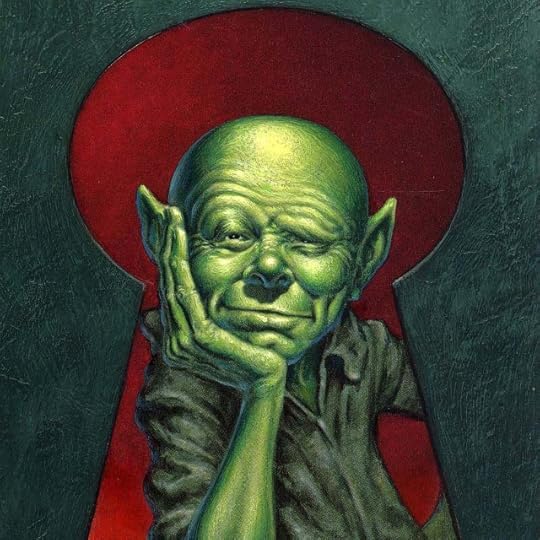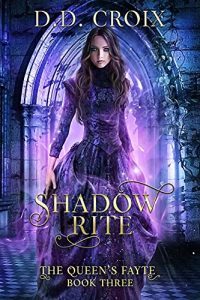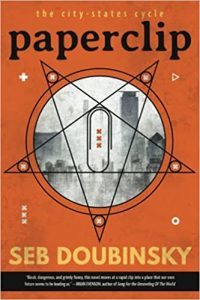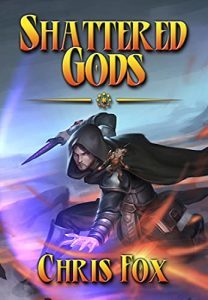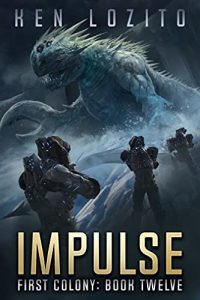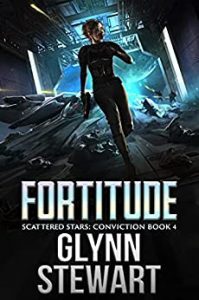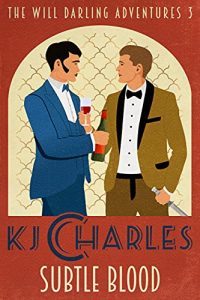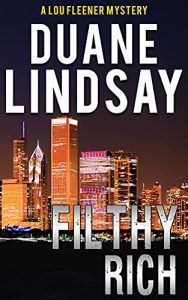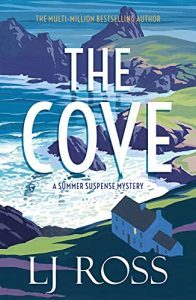Cora Buhlert's Blog, page 37
September 5, 2021
First Monday Free Fiction: The Revenant of Wrecker’s Dock
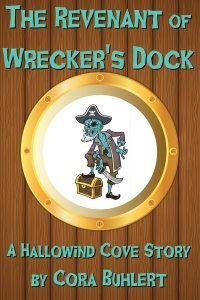 Welcome to the August 2021 edition of First Monday Free Fiction.
Welcome to the August 2021 edition of First Monday Free Fiction.
To recap, inspired by Kristine Kathryn Rusch who posts a free short story every week on her blog, I’ll post a free story on the first Monday of every month. At the end of the month, I’ll take the story down and post another.
The foggy season is beginning, so it’s an excellent time to visit the quaint little seaside town of Hallowind Cove, where it’s foggy some 340 days of the year (the other twenty-five days are lovely and sunny). However, that’s not the only problem Hallowind Cove has, for the town is also known as “the Harbour of the Weird”, because strange things keep happening there.
The first Hallowind Cove story The Revenant of Wrecker’s Dock was originally written for a shared world anthology that fell through, so I scrubbed off the shared world serial numbers and self-published it. Afterwards, I’ve revisited Hallowind Cove and its equally quirkey inhabitants a number of times and there’s at least one more story coming in the series.
So accompany Paul MacQuarie, a newcomer to Hallowind Cove, as he spends an evening at The Croaking Foghorn pub and faces…
The Revenant of Wrecker’s DockPaul pulled up the collar of his coat against the ever-present fog that enveloped the town of Hallowind Cove. His hair was damp, his skin clammy, every bone in his body ached and the cough he’d developed shortly after coming to Hallowind Cove was back, worse than ever.
One day, this town was gonna be the death of him.
He turned onto Wrecker’s Dock in Hallowind Cove harbour or what passed for it, cause these days, the docks were mostly deserted with only the occasional fishing boat moored at the quay.
The fog was even thicker here, rolling in from the sea in waves of white. Walking along the seafront probably wasn’t the best of ideas, considering that the fog was making him sick. But Paul did not care. He was headed for The Croaking Foghorn, a harbourside pub that offered beer and stronger drinks as well as some of the best and freshest seafood dishes Paul had ever seen.
A raven set perched on one of the tar-covered bollards along the quay, fixing Paul with unnerving eyes.
“Wa-atch out,” the raven croaked, “Wa-atch out!”
Or at least that’s what it sounded like. For of course birds couldn’t talk, even though this one gave a pretty good impression of it. Paul had seen the raven before, hanging around town and emitting croaks that sounded uncannily like words.
He’d once asked Ian, landlord of The Croaking Foghorn and the closest thing Paul had to a friend here in Hallowind Cove, about the raven.
“Oh, that’s just Hugo,” Ian had said, “Never mind him. He likes to pretend he’s a harbinger of doom, but he’s really quite harmless.”
“Wa-atch out,” Hugo croaked again, “Wa-atch out.”
“Shut up, Hugo,” Paul said good-naturedly, “I’m no longer a newbie. I won’t fall into the harbour basin.”
“Wa-arned you,” the raven croaked.
Paul shook his head. “I’m really going crazy,” he thought, “Hell, I’m talking to a bird.”
He held on steady towards the lights of The Croaking Foghorn, blurred by the dense fog. A dark figure stumbled towards him, emerging from the mist and gradually coalescing into a solid form. The figure was clad in a seaman’s oilskin jacket and sou’wester.
Probably a fisherman headed out to sea, Paul thought. He shouted a friendly greeting as he passed the stranger, but then his words caught in his throat, as he got a closer look at the dark figure.
For the dark figure’s oilskin jacket and sou’wester were encrusted with molluscs and draped with seaweed. Its skin had a pallid and faintly greenish cast, the sort of look that only the long dead should have. And where its eyes should be, there were only two black holes.
“Murrrderrr,” the figure moaned, its voice sounding as if it came straight from the bottom of the sea, “Deathhh. Deceit.”
The creature reached out for Paul and where its hand should be, there was only a hook, a rusty iron hook.
“The Mary Durban, lost with all hands on board,” the creature said and lurched towards Paul, hook raised. “Vengeance,” it moaned.
Paul screamed and ran along the dock, towards the lights of The Croaking Foghorn and the salvation they promised, the shambling, lurching figure hot in pursuit.
Panicked and panting, he reached the pub and crashed through the door, startling both Ian, the landlord, and Old Hank, a drunk who seemed to be a permanent fixture on the second barstool from the left.
“I… I…” Paul bent over, gasping for air. “I think I just saw a zombie.”
He turned the key in the lock and looked for something, anything, to bar the front door. Finally, he grabbed an old oar from the wall and placed it across the door. Only that it wouldn’t hold the door, not for long and certainly not without some nails for reinforcement.
Already, he could hear the zombie scratching on the door, looking for a way in.
“A hammer,” Paul blurted out, “I need a hammer. And nails.”
“Sit down and relax,” Ian said, entirely unperturbed. He drew a beer from the tap and put it down on the counter. “And would you kindly refrain from blocking the door. There’s few enough punters about in this weather as it is, so I really don’t need you locking out the few that might stumble in.”
“But there…” Paul was only gradually getting his breath back. “…there’s a zombie out there and it’s after me.”
Ian nodded. “So you said. And now sit down and drink your beer, before it gets warm.”
The beer stood on the counter, bubbling golden and foamy white, beckoning, inviting Paul to just take a sip and forget his panic. So he sat down and took a big gulp, savouring the bitter liquid running down his parched throat.
He could still hear the zombie outside, moaning and scratching at the door, but somehow it didn’t sound quite as bad as before. Or maybe that was just the beer talking.
Paul sat down the glass and narrowed his eyes at Ian. “You don’t seem overly surprised by this. I mean, I was just chased by a zombie, a freaking zombie.”
Ian shrugged. “This is Hallowind Cove. Weird crap happens here on a regular basis.”
“Even zombies?”
“Ah well, zombies are perhaps a bit weirder than usual.” He shrugged. “Still, this is Hallowind Cove.”
Paul turned to Old Hank who was currently nursing his third or fourth beer of the evening. “What about you, Hank? Have you ever seen zombies in Hallowind Cove before?”
“Sure,” Hank slurred, “Back in ’56, when that Haitian freighter came in, the entire crew were zombies. Glassy eyed, creepy, the living dead. Turned out the captain was an evil voodoo priest who’d enslaved them and…”
Paul cut him off. “No, not that kind of zombie.” Though Haitian voodoo zombies would be weird enough for any place that was not Hallowind Cove. “That other kind, the sort of hunts people and eats brains.”
“Oh, that kind.” Old Hank shook his head. “No, we ain’t never had that kind of zombie here.”
“Well, there is one now,” Paul insisted, “Waiting just outside the pub. And he threatened me, said something about murder, death and vengeance.”
It was still out there, too, moaning and wailing and trying to get in.
Ian narrowed his eyes. “And you’re sure you’re not just making it all up?” he asked, “After all, everybody knows that zombies don’t talk.”
“Well, this one did,” Paul said and took another gulp of beer, “He talked about murder and death and vengeance. Oh yes, and something else. Something about a… ship? Yes, I think it was a ship. The Mary… Mary something or other. Lost with all hands on board, at any rate.”
A shimmer of recognition lit up the barkeeper’s face and even Old Hank seemed to wake from his alcohol-induced stupor for a moment. “The Mary Durban?” Ian asked.
“Yes, that’s it. The Mary Durban. That’s exactly what the zombie said.” Paul shot Ian a sceptical glance. “Why? Ring any bells?”
“It does. It sure does,” Ian said, while Hank nodded sagely.
“So what is it?”
“You’d better have another drink…” Ian said and promptly drew a beer from the tap, “…cause it’s a long story.” Ian set the second beer down in front of Paul, though he hadn’t finished his first yet. “And by the way, that thing you saw wasn’t a zombie.”
“So you know what it was?”
Ian nodded. “It was the revenant,” he said, “Though I have no idea why it was bothering you.”
“Revenant, zombie, that’s all the same, isn’t it?”
Ian shook his head. “Oh no. Revenants are the dead risen from their graves to wreck revenge on the living…”
“Like I said, zombies.”
“…while zombies are the dead risen from their graves to eat the living and their brains.”
“So in short, ‘revenant’ is just a fancy word for ‘zombie’,” Paul concluded.
Ian rolled his eyes, while outside the zombie or revenant or whatever it was called was still scratching on the door with his horrible hook.
“So what’s the story of this zom… — err, revenant?” Paul wanted to know.
Ian lowered his voice to the kind of tone that suggested he was about to impart a great secret. “Do you know why this place is called Wrecker’s Dock?” he asked.
“What’s that got to do with anything?”
“Well, do you know?”
“Not really,” Paul admitted, “Though I suspect it’s got something to do with shipwrecks off the coast. Or maybe that old ship scrap yard down the road…”
“And that’s where you’re wrong,” Ian said, “Cause Wrecker’s Dock is named for…” He lowered his voice even further. “…the wreckers.”
“You mean people who demolish ships?” Paul said, “I saw a documentary about that once. People in India breaking up decommissioned ships. Horrible working conditions, exploitation, child labour and all that.”
“Well, what used to go on here in Hallowind Cove was a bit like what’s happening in India right now, though without the child labour and bad working conditions. What is more, the people here didn’t always wait until the ships were decommissioned. Instead, they made their own wrecks.”
Paul had no idea what Ian was talking about, so he raised his glass — still his first glass — instead and took another gulp of beer.
Nonetheless, Ian must have sensed his confusion, because he continued, “Well, here’s a bit of history for you, my friend. You know what makes Hallowind Cove famous, do you?”
“Uhm, the fog,” Paul said.
“Exactly, the fog. And what does fog at sea mean?”
“Low visibility, difficult navigation, danger,” Paul rattled off.
“And wrecks, my friend. Lots of shipwrecks. Especially since we’re not just cursed with over three hundred days of fog a year, but also with dangerous cliffs, shoals and treacherous currents. So over time, a lot of ships got wrecked on this coast. And do you know what happens to the cargo, when a ship is wrecked?”
Paul shrugged. “I’m not sure. It’s… recovered?”
“Salvaged is the word you’re looking for, my friend. And do you know to whom the cargo that’s salvaged belongs?”
“No idea. Does it matter?”
“It belongs to whoever salvages it. And with so many shipwrecks happening off the coast, the good people of Hallowind Cove were making a good living of the salvaged cargo. So good that some of them decided to create some wrecks of their own to salvage.”
Old Hank nodded emphatically. “Aye, they did,” he announced and raised his glass, while Paul took another gulp of his own.
“So on particularly misty nights…” Ian continued, “…the good people of Hallowind Cove shut down the lighthouse at Foghorn Point and set false lights on the cliff tops instead. And those false lights lured unsuspecting ships to their doom, until they stranded on the shoals or crashed against the cliffside…”
Ian executed a dramatic pause, complete with a theatrical shudder.
“Once a ship had run aground on the shoals or been smashed against the cliffs, the false lights were extinguished and the wreckers took over…”
“Aye, the did,” Hank declared and raised his glass.
“They snatched the cargo and whatever other valuables were to be found on board. And if there were any survivors left on the wrecked ship…”
Old Hank made a throat-slitting gesture, while the revenant emitted a matching wail outside.
“…they killed them, so they couldn’t dispute the wreckers’ claim to the salvaged cargo.”
“Aye, they did.”
Outside, the revenant’s wailing increased in pitch and volume.
“And because the good people of Hallowind Cove only went wrecking once in a while, it took the authorities some time to catch on. Wrecks happen and this coast is treacherous, after all, with the fog and the cliffs and the shoals…” Ian shrugged. “Once in a while, someone did catch on to what the good people of Hallowind Cove were doing and they captured, tried and hanged a few wreckers down on Gallows Square…”
Old Hank made a wrung neck gesture, complete with grisly sound effect. Outside, the revenant screeched.
“Then the wrecking stopped for a few years, but it always started up again. Until the ships became ever bigger and began to pass by our harbour and our coast.”
Hank and Ian both looked at Paul expectantly, awaiting a reaction. Even the monster outside the pub had fallen silent.
“Well, that’s a really cool horror story and all that,” Paul finally said, “But what’s all that got to do with the zombie — pardon, revenant — I just saw outside? The one that’s been scratching on the door these past couple of minutes”
“One of the ships the wreckers tricked with false lights…” Ian intoned, “…was a freighter called the Mary Durban. She ran aground on the shoals on a foggy November night in the year of the Lord 1873…”
“Aye, she did,” Hank confirmed and took another gulp of beer.
“The Mary Durban was carrying a cargo of brand new gold bars. Someone had tipped off the wreckers and so they were after the gold…”
“Aye, they were.”
“That night, a horrible storm raged along the coast and so the Mary Durban was already in trouble, her sails tattered and her mast broken, by the time she reached Hallowind Cove. When her crew spotted the beacon at Foghorn Point, the light must have seemed like salvation. But they were betrayed…”
“Aye, betrayed.”
“Because the Mary Durban was already damaged and battered by the storm, she broke apart as soon as she ran aground. Most of the crew were already drowned by the time the wreckers got there. But the captain was still alive, clinging to the planks of his shattered ship by sheer willpower. When he saw the wreckers approach, he thought he was saved. But then they murdered him…”
“Slit his throat, aye, they did,” Old Hank announced with the respective gesture.
“Actually, the way I know the story, they clubbed him to death,” Ian snapped.
“Does it matter?” Paul wanted to know, “Dead is dead, after all.”
He realised that his throat had gone dry and took a gulp of beer from the second glass Ian had handed him.
“So this zombie — err, revenant — is…?”
“Exactly, the captain of the wrecked Mary Durban,” Ian replied, “They say that in his very last moments on Earth, he vowed revenge on those who had wronged him, who had lured the Mary Durban to her doom and slain him and his crew…”
“Aye, he did.”
“And so on those nights when the fog was at its densest, the revenant rose from his watery grave to terrorise those responsible for the wrecking of the Mary Durban. Over the next few years, several of the former wreckers, now wealthy citizens of Hallowind Cove due to the salvaged gold bars, died under mysterious circumstances. They tumbled into the harbour basin and drowned, even though they’d lived here in Hallowind Cove all their lives. Or they dropped dead in the street right here at Wrecker’s Dock. Their hearts just stopped after they’d been chased down the dock by a nameless horror…”
“Aye, so it was.”
Outside, the revenant emitted a howl of agreement.
“Eventually, all of the original wreckers had died or fled Hallowind Cove in terror. But the revenant, he did not vanish, for his work was not yet done. Instead, he began to terrorise the descendants of the wreckers and then their descendants. Since the revenant only ever attacks people on Wrecker’s Dock and since he only strikes on nights when the fog is particularly dense, he’s easy enough to avoid…”
“Aye, he is.”
“Though the revenant does play hell with my business, because on extremely foggy nights few folks dare come to The Croaking Foghorn.” Ian shrugged. “Lots of people here in Hallowind Cove are descended from the wreckers.”
“But not you and Hank?”
Ian shook his head. “My great-great-grandpa was the sheriff of Hallowind Cove back in the day, so the wreckers kept him out of their schemes. And Hank’s family were carnie folks who got stranded here in the Thirties.”
“Well then, if this z… revenant only targets the descendants of those who murdered him, then why the hell is he bothering me? I’m not from Hallowind Cove, In fact, I’ve never been here before in my life.”
Ian frowned and stroked his beard. “That’s the big question.”
Hank nodded affirmatively. “Aye, it is.”
Outside, the revenant had started scratching and banging on the door again.
“Shut up and get lost,” Ian yelled at the locked and barred door, “You’ve got the wrong guy.”
Paul suddenly experienced an almost absurd sense of relief. “So you can hear him, too?”
Ian shrugged. “Sure I can. But in my experience, he tends to go away, when he’s ignored.”
“Aye, he does,” Hank declared.
Ian reached out across the bar and patted Paul on the shoulder. “And don’t worry yourself, he can’t get in here. Something in the rules of revenantism forbids him to enter any houses. All he can do is stalk the dock.”
“Well, that’s very comforting,” Paul said, taking a gulp of beer.
Ian narrowed his eyes. “Say, why did you come to Hallowind Cove again?” he wanted to know, “Some kind of inheritance issue, wasn’t it?”
Paul nodded. “A distant uncle I’d never even heard of suddenly decides to leave his house to me, for reasons best known to himself.”
“May he rest in peace,” Hank said sombrely and raised his glass in memory of a man he likely hadn’t known any better than Paul himself had.
“And that house, where would it be?” Ian asked.
“On — what’s it called again? — Gloomland Street. A ramshackle Victorian dump.”
“Gloomland Street, hmm.” Ian scratched his chin and gave Paul a speculative look. “Is that perchance Old Jim Bob’s place?”
Paul’s face lit up. “Yes, James Robert MacQuarie. That was my uncle’s name.”
“Well, that explains things then,” Ian said, while Hank nodded sagely.
“Aye, it does.”
“The fact that my uncle left me a house on Gloomland Street explains why I was attacked by a zombie?”
“It certainly does, if you know that old Jim Bob MacQuarie was a direct descendant of Jedediah MacQuarie, leader of the wreckers on the night the Mary Durban sank.”
“And besides, it’s no zombie, it’s a revenant,” Old Hank piped in.
“So this zom — errr, revenant — is bothering me, because some distant ancestor of mine was involved in killing him?”
Ian beamed at him. “Now you got it, lad.”
Paul wasn’t nearly so sanguine about the revelation. After all, here was a zombie or revenant or whatever the hell that thing was and it wanted to kill Paul because of something that the ancestor of a distant uncle he’d never even heard of may or may not have done more the a hundred years ago.
“Well, what am I supposed to do about it?”
“Don’t go down to the docks on nights when the fog is particularly dense,” Ian said with a shrug, “Of course, this also means that we’ll have to miss your esteemed company here at The Croaking Foghorn, but then we’re missing half the bloody town here on foggy nights, cause the revenant scares them away…”
“Aye, we do,” Hank announced.
“And you’ve been no fun tonight either,” Ian said, “Barely touched your second beer and didn’t even glance at the lovely fresh mussels I’ve got on the menu tonight.”
“Well, you can hardly expect me to eat mussels, when there’s a zom… — revenant — outside trying to kill me,” Paul replied testily.
Ian just shrugged. “What else are you gonna do? Especially since you can’t go home either.”
“Oh God!” Paul pressed a hand to his forehead. “I hadn’t even thought of that.”
“Lucky for you that I did,” Ian said, “Cause the revenant knows no mercy. And ‘I’m new in town and don’t know nothing’ ain’t an excuse he accepts.”
“Nay, he doesn’t,” Hank piped in.
Now Paul did take a gulp of his second beer, though it did little to calm his agitated nerves.
“So what do I do now?”
In response, Ian picked up a glass and wiped it with a dishcloth, though to Paul’s eyes it didn’t look like it needed cleaning.
“Simple. First of all, you stay here for the night, cause the revenant’s power fades once the day breaks. I’ve got a spare guestroom and we’ll find a toothbrush for you somewhere…”
Paul let out a sigh of relief. “Thanks, Ian. You’re a true lifesaver.”
“You won’t say so when you see the bill.”
“Given there’s a bloodthirsty zombie after me, I can’t afford to be miserly.”
“Are you sure you don’t want any mussels? I mean, since you’re stuck here and everything…”
Paul sighed and took a draft of beer. “Okay. Might as well eat, since it seems I’ll be spending the night here anyway.”
With a zombie just outside the door, howling for Paul’s blood, oh joy of joys!
“Anyway…” Ian put down the glass he’d been wiping and promptly picked up another. “…that’s just the short-term solution to your immediate problem.”
“Aye, it is,” Hank said and took a gulp of what had to be his umpteenth beer
“Medium term…” Ian continued, “…you keep the hell away from the docks after dark on nights when the fog is particularly dense. Of course, that also means I’ll be missing my favourite customer, but that’s life in Hallowind Cove for you.”
“And long term?” Paul wanted to know.
“Long term…” Ian put down the glass and picked up the next. “…you sell that house on Gloomland Street and get the hell out of Hallowind Cove.”
“Aye, get the hell out,” Hank echoed.
“Sell the house”, Paul said and downed the rest of his beer, “Sure, that would be nice. Now I just need someone stupid enough to buy it.”
“Oh, someone will buy it,” Ian said, brimming with confidence, “A nice young couple. He’s an investment banker or a lawyer, she works in advertising or the media. They’ve got more money than they know what to do with and now they’re tired of city life and want to enjoy the peace and calm of the seaside.”
“Peace and calm?” Paul emitted a bitter laugh. “In Hallowind Cove?”
Ian leant across the bar, until he was eye to eye with Paul. “But our young couple doesn’t know that, do they? And by the time they find out, it’s too late.”
“Aye, it will be,” Hank said forebodingly.
“So this has happened before?”
“Aye, many times.”
Ian nodded in agreement. “You may have noticed that Hallowind Cove can be quite charming when the sun is shining and the fog recedes…”
“Which happens how often? Two weeks a year?”
“That’s beside the point,” Ian said, “It happens.”
Hank nodded emphatically. “Aye, it does.”
“And when the weather’s nice, that’s when the tourists and the daytrippers come. And some of ‘em, god bless them, inevitably fall in love with the town and buy up all the empty real estate.”
“So they do,” Hank added.
“And once they figure out what’s really going on?” Paul wanted to know.
“Most of them last two months, maybe three, then they flee back to wherever they came from,” Ian said, “But that’s not your problem, cause you’ll be long gone by then. With a hefty cheque in your pocket.”
He eyed Paul’s empty glass. “Another drink?”
Paul glanced at his watch and sighed. It was going to be a long night. “Might as well.”
“Same as before?”
Paul shook his head. “I think I need something stronger.”
“Aye, you do,” Hank agreed.
“What you need…” Ian said, “…is a good hot mug of grog.”
“Grog? The cliché pirates’ drink?”
“Nope, grog, the traditional sailors’ drink. Best thing to keep you warm on a cold and foggy night.” Ian poured some water into an electric kettle and pressed the “on” button.
“Aye, it’ll keep you warm and keep the revenant away,” Hank echoed.
As if on cue, the revenant hammered his hook into the wooden door and wailed something about death and deceit and murder and vengeance.
Paul shot Hank a sideways look. “I thought the revenant couldn’t enter this establishment.”
“Nay, he can’t,” Hank said.
“But a good hot grog will make you forget he’s even out there,” Ian added. As if to prove his point, he poured a generous helping of rum into a hula girl tiki mug and added a lump of rock sugar and a dash of lime juice.
“Actually, that’s something I’d rather not forget,” Paul said, “After all, I don’t want to end up like the revenant’s other victims.”
“Oh, don’t worry yourself,” Ian said briskly, “After all, the good people of Hallowind Cove have managed to avoid the revenant just fine these past one hundred and forty years.”
“Somehow that doesn’t fill me with confidence,” Paul said.
“You’re not being fair,” Ian began.
At just this moment, the kettle buzzed. Ian filled up the hula girl mug with hot water and handed it to Paul. He poured himself a shot of rum without the extras and raised his glass.
“To Hallowind Cove, the best little town to live in.”
“Aye,” Hank added, raising his own glass.
Paul raised his drink as well, enjoying the heat of the grog as it radiated through the walls of the hula girl mug.
“To Hallowind Cove, harbour of the weird.”
The End
***
That’s it for this month’s edition of First Monday Free Fiction. Check back next month, when a new free story will be posted.
August 31, 2021
Fancast Spotlight: Unknown Worlds of the Merril Collection
It’s time for the next entry in my Fanzine/Fancast Spotlight project. For more about the Fanzine/Fancast Spotlight project, go here. You can also check out the other great fanzines and fancasts featured by clicking here.
Today, I’m pleased to feature the Unknown Worlds of the Merril Collection, a podcast focussed on the Merril Collection of Science Fiction, Speculation and Fantasy at the Toronto Public Library.
Therefore, I’m happy to welcome Oliver Brackenbury of Unknown Worlds of the Merril Collection to my blog.
Tell us about your podcast or channel.
Unknown Worlds of the Merril Collection is a podcast where host Oliver Brackenbury (that’s me!) interviews special guests about notable history and new frontiers in the worlds of science fiction, fantasy and horror as found in Toronto’s Merril Collection, the Western Hemisphere’s largest publicly accessible archive of genre materials.
Who are the people behind your podcast or channel?
I host, screenwriter Chris Dickie is the producer, and ultimately the Friends of Merril volunteer group are behind the show. The Friends of Merril are dedicated to spreading awareness of, and otherwise supporting, the Merril Collection of Science Fiction, Speculation & Fantasy – located on the 3rd floor of the Lillian H. Smith branch of the Toronto Public Library system. With over 80,000 spec fic texts going back over two hundred years, it’s a tremendous asset for writers, scholars, and readers, one I’ve benefited from greatly.
Why did you decide to start your podcast or channel?
Well, Chris had just joined the Friends and when I asked him if he had anything specific he’d like to try in promoting the Merril, he said he’d been wanting to try podcasting. I’d been wanting to create some kind of shareable promotional content for the Merril, and had plenty of experience with hosting from my old Youtuber days. So, we figured we’d give it a whirl and see if it helped spread awareness of the Merril!
As far as I can tell, it’s certainly helped spread the good word. But we can always do more!
What format do you use for your podcast or channel and why did you choose this format?
We kept it pretty straightforward; Opening music, then I do a little intro of first the show and our guest, then we dive straight into the interview. There I usually ask around ten questions or so and when it feels right, I’ll wrap things up with a little outro blurb, then there’s music to ride us out. We figured it was best to keep it simple, as it was our first time making a podcast, and to focus on the guest, as each episode is really about the subject in which they’re knowledgeable, not me being in love with the sound of my own voice.
For distribution, we’ve decided to do a seasonal format, in that we’ll record a block of episodes – eight for season one – and only release them once they’re all ready to go. Then it’s once a week, early Monday morning, every week until the season is done.
The reason for this is twofold. First, we’re volunteers who have to negotiate both our own busy lives and the schedules of our guests in order to make the show. A regular, weekly format would be truly difficult unless somebody wanted to pay us to make it our jobs.
Secondly, having them all edited before release also takes the stress off Chris, and releasing them weekly gives the show room to build a little momentum. Think about your streaming habits. How deeply have you gotten into shows that dump everything all at once, versus the weekly model? It’s fun to binge, but the conversation around the show can end in less than a week and I’ll be damned if I don’t have more trouble remembering what happens in shows with that release model than the weekly variety.
Anyway, season two will happen when it happens, but I can safely say that as of this writing we’ve recorded two episodes, have the next recording scheduled, and are aiming for a minimum of eight more episodes. Ideally it’ll start coming out before year’s end.

The Lilian H. Smith branch of the Toronto Public Library, home of the Merril collection
The fan categories at the Hugos were there at the very beginning, but they are also the categories which consistently gets the lowest number of votes and nominations. So why do you think fanzines, fancasts and other fan projects are important?
Well, where the heck are creators (and the multi-media conglomerates that feed off them) without fans? Going all the way back to things like Amra and beyond – wasn’t there a Sherlock Holmes fan group or fifty back in the Victorian age? They must have made some things. – fans have wanted to create works inspired by what they love, and connect with each other. Hell, I’m sure there were some papyrus fanzines going around Ancient Egypt.
Point being that I think fan culture can be unfairly tagged as being ephemeral, but really it’s not and it is important if only for the long history it has, as much as the vital role in supporting creative works and nurturing various social scenes for people to connect with one another.
It’s funny, I have a few friends that voraciously post about their fav bands. I am not into these bands, but I am into how into these bands they are, if that makes sense? As long as it’s expressed in a non-toxic way, passion is inspiring and life-affirming! Ultimately it’s that raw energy that makes fanzines, fancasts, and other fan projects important, I reckon.
In the past twenty years, fanzines have increasingly moved online and fancasts have sprung up. What do you think the future of fan media looks like?
I’m a terribly unskilled prognosticator, I’m afraid. Funny enough there’s a soon-to-be-retired employee of the Merril Collection who is incredibly knowledgeable about the history of fandom. We’ve all been encouraging her to write a book on the subject, one which I’m sure would look to the future as well. Fingers crossed she does it!
The four fan categories of the Hugos (best fanzine, fan writer, fan artist and fancast) tend to get less attention than the fiction and dramatic presentation categories. Are there any awesome fanzines, fancasts, fan writers and fan artists you’d like to recommend?
I’m a big fan of Ngo Vinh-Hoi (@NgoVinhHoi on Twitter), who co-hosts The Appendix N Book Club podcast with Jeff Goad, but also frequently writes columns on the history of Appendix N / Sword & Sorcery works of yesteryear for the blog on www.goodmangames.com
Where can people find you?
Unknown Worlds of the Merril Collection
The Merril Collection of Science Fiction, Speculation and Fantasy
Friends of the Merril Collection
Friends of the Merril Collection on Twitter
Thank you, Oliver, for stopping by and answering my questions.
Do check out Unknown Worlds of the Merril Collection, cause it’s a great podcast.
***
Do you have a Hugo eligible fanzine/-site or fancast and want it featured? Contact me or leave a comment.
August 30, 2021
Indie Speculative Fiction of the Month for August 2021

It’s that time of the month again, time for “Indie Speculative Fiction of the Month”.
So what is “Indie Speculative Fiction of the Month”? It’s a round-up of speculative fiction by indie and small press authors newly published this month, though some July books I missed the last time around snuck in as well. The books are arranged in alphabetical order by author. So far, most links only go to Amazon.com, though I may add other retailers for future editions.
Once again, we have new releases covering the whole broad spectrum of speculative fiction. This month, we have urban fantasy, epic fantasy, portal fantasy, historical fantasy, gaslamp fantasy, YA fantasy, sword and sorcery, paranormal mystery, paranormal women’s fiction, dystopian noir, space opera, military science fiction, hopepunk, solarpunk, occult thrillers, horror, vampires, werewolves, dragons, fae, gargoyles, ghosts, space marines, aliens, superheroes, bounty hunters, mercenaries, crime-busting witches, spooky railroads, frozen citadels, living swords, satanic cults, shattered gods, supernatural circuses and much more.
Don’t forget that Indie Speculative Fiction of the Month is also crossposted to the Speculative Fiction Showcase, a group blog run by Jessica Rydill and myself, which features new release spotlights, guest posts, interviews and link round-ups regarding all things speculative fiction several times per week.
As always, I know the authors at least vaguely, but I haven’t read all of the books, so Caveat emptor.
And now on to the books without further ado:
It doesn’t matter what’s after you. The only thing that counts is who’s in your corner.
Bessie is just meant to be an ordinary journalist. Okay, she’s kinda scatty, bolshie, and has never backed down from a story – or a fight. But when a fight comes to her that could consume the whole city, there’s only one person she can turn to.
Xavier Kilmer is a ghost vampire. He’s also Bessie’s sworn enemy. The animosity isn’t mutual. Three years ago, he met her and sparks flew. Ever since, every paper in town has promised she’s his true mate.
But right now, all Bessie needs is a miracle. When a shadowy force called the Ghost King reaches through the dark to claim her as his bride, only Xavier can help. But all help comes at a cost.
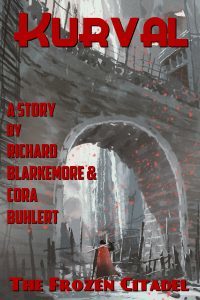 The Frozen Citadel by Richard Blakemore and Cora Buhlert:
The Frozen Citadel by Richard Blakemore and Cora Buhlert:
Before Kurval became King of Azakoria, he plied his trade as a wandering mercenary and sword for hire.
Kurval and his friend and fellow mercenary Tsabo are planning to take up service at the citadel of Harjula in the frozen north of the kingdom of Simola. But when they finally reach the citadel, they find it deserted, its inhabitants in the thrall of dark magic…
The new sword and sorcery adventure by two-time Hugo finalist Cora Buhlert and her occasional alter ego, 1930s pulp writer Richard Blakemore. This is a short story of 5900 words or approx. 22 print pages in the Kurval sword and sorcery series, but may be read as a standalone. Includes an introduction and afterword.
 Broken by Magic by Lindsay Buroker:
Broken by Magic by Lindsay Buroker:
Even before our heroes discovered a portal to other realms, Jak Freedar wanted to seek out powerful allies to help overthrow the tyrannical wizard rulers of his home world. Instead, he chanced across a dragon egg and is now the surrogate father of a hatchling.
Since he found the egg, taking care of the young dragon is his responsibility. Even as King Uthari forces the team to prepare for another mission, Jak must do his best not only to care for the hatchling but to keep it safe from those who want to use it for their own gain.
As he soon learns, it’s not only the wizards of his own world who would love to control a dragon. It turns out that powerful enemies in other realms want a hatchling too. And they’re willing to kill for it.
A desperate Fayte Guardian trapped in a distant world. A ruthless fae queen craving revenge. Can justice prevail in this dangerous clash of wills and dark magic?
Ripped from her world and her Fayte Guardian friends, Jane Shackle finds herself captive to a vengeful queen in a strange, otherworldly realm filled with mythical creatures, dangerous magic, and shocking clues to the secrets in her past.
When an old ally comes to her rescue, Jane discovers redemption for her past wrongs may be within reach—until a bittersweet revelation changes everything. Since her life isn’t the only one hanging in the balance, Jane must forge new alliances and fight harder than ever to survive and protect those she loves.
Can she defeat her powerful enemy and find a way back to her own world where true love awaits, or will the fight follow her home and destroy everything she holds dear?
SHADOW RITE is the final episode in The Queen’s Fayte trilogy, a thrilling dark fantasy adventure that weaves captivating mystery into the hidden corners of history to keep you spellbound. If you like clever heroines, ruthless villains, and a slow-burn romance tangled up in the Victorian world, then you’ll love this enchanting series from best-selling author D.D. Croix!
 Railroad Tales, edited by Trevor Denyer:
Railroad Tales, edited by Trevor Denyer:
Have you ever been on a train going to a destination you don’t want to reach? What about a train travelling through the night, where you are the only passenger in the carriage? Or maybe standing alone on a platform, waiting for a train you hope will come?
Have you ever wondered about the history behind a train journey, or a station? How many people have travelled the line, or died during its construction?
Has a shiver ever run up your spine as dead leaves scrape across the platform, propelled by a breath of wind on a quiet night? Have you ever wondered whether what you heard was a sigh, or a whisper, or just your imagination?
There are many stories involving railroads, trains, stations, junctions and crossings. Stories about people journeying towards unknown futures that may involve life changing events, or death, or revelations.
The 23 stories in this anthology play upon those fears and uncertainties. Each one explores the journeys we might take into horrific, supernatural or extraordinary futures. Guilt, unresolved desires and disbelief all play their part in creating vivid and disturbing nightmares from which there is no escape, or from which a frightening lesson is learned.
The train awaits, ready to carry you along tracks that disappear into darkness. Somewhere out there are the horrors that we all imagine and hope will never happen.
Enjoy the journey…
As it turns out, being a masked, superpowered vigilante isn’t entirely legal. Who knew?
When a critically ill teenager with powers disappears, part-time superhero and full-time trouble magnet Zita Garcia is on the case. Unfortunately, the girl isn’t the only person to have disappeared, and the culprit isn’t a mystery. It’s a conspiracy.
A shadowy government agency has escalated from irritating robocalls to the obvious next steps, kidnapping and murder. If an intolerant new party can use rising anti-metahuman sentiment to win an upcoming election, their actions might not even be a crime. All Zita and her friends have to do is save the missing and avoid the bad publicity of doing something stupid that would tip the delicate political situation the wrong way…
They’re doomed.
Party is the sixth in the Arca superhero urban fantasy series and contains lame sexual innuendo, immoderate language, and comic book violence.
In New Babylon, leader of the Western alliance of the city-states, armament mogul Kurt Wagner has a secret dream: to build a space station to save mankind. Little does he know that he is the target of competing plots involving geopolitics and black magick. In the background, a film director with a political conscience, a bodyguard with a secret mission, a driver with an occult hobby and a talking bird are trying to make sense of their world, hoping to see their wishes come true – which they will, but not in the way they might have expected.
Fated to destroy the world. Determined to save it.
My name is Xal and I live in the dims, a walled prison where my people are kept by our cruel masters, until we are needed to fight once more. One member of every family must answer The Call, for our blood bears the magic of a demonic god, and all the terrible power that brings.
We march to war against the Fomori, an unstoppable army of giants, and their behemoths. If we do not, then our families are put to death. The Hasrans use us as cannon fodder, and worse. They used up my father, and he never came home. Die resisting. Die fighting. My choice isn’t if it happens, but rather how I sell my life.
If by some miracle I survive I will be granted entrance to the Imperial Academy, where every noble house will vie to architect my end. They cannot allow the void-blooded to live. They cannot allow us to thrive, or to gain more magic from the bodies of other dead gods. They cannot allow us to win. They fear the rise of another dreadlord. And they are right to fear. I will pull down an empire, and that is just the beginning.
 My Brew Heaven by Lily Harper Hart:
My Brew Heaven by Lily Harper Hart:
Ofelia Archer should be riding high after a blissful week spent with her boyfriend Zacharias “Zach” Sully. Sun, fun, and cocktails make for a great break … until she gets home. Then she realizes exactly how far things can fall apart in only a few days.
It seems in her absence Ofelia’s mother Marie Charles has been taken in by a cult, and Ofelia is convinced it’s not the sort of group who worship beignets over chaos and bloodshed. When Ofelia tries talking to her mother she finds a different woman waiting for her … and she’s beyond concerned.
The French Quarter attracts weird people but this time the strife is different. When she starts digging, she finds more than she bargained for … and yet the answers are less than she was hoping for.
Ofelia is a witch with a plan but even she’s at a loss. When her brother Felix is hurt in the pursuit of reclaiming Marie, the Quarter’s favorite magical maven swears revenge … and she’s going to need Sully to help her deliver it.
Their new enemy is powerful and he’s hiding behind a gaggle of innocent humans. Freeing the French Quarter from his grip leads Ofelia down a dark path. Only Sully can help her … and together they will bring their city back from the brink.
The question is: Will they both survive to enjoy the fruits of their labor once they make it to the other side?
 Becoming Crone by Lydia M. Hawke:
Becoming Crone by Lydia M. Hawke:
She wanted purpose. She got dark magic and war.
Claire Emerson is adrift. After a lifetime as a wife, mother, and grandma, she never saw divorce or loneliness coming and is desperate for some sense of purpose. But when her sixtieth birthday brings a snarky gargoyle, an annoyingly sexy wolf shifter, and an unknown magical calling, she thinks she’s losing the only thing she has left: her sanity.
Refusing to believe she’s the powerful defender of humankind her so-called protectors claim, Claire attempts a return to her safe life… only to have her powers ignite when she’s attacked by dark supernatural creatures. And without the training she was supposed to have received, she has no idea how she’ll defeat sinister mages plotting her demise.
Can Claire overcome creaky joints and major hot flashes in time to save the world – and her own life?
Becoming Crone is the page-turning first book in The Crone Wars paranormal women’s fiction series. If you like spunky heroines, snappy banter, and triumphing over self-doubt, then you’ll love this ageless adventure.
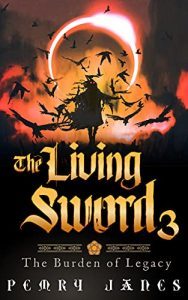 The Living Sword 3: The Burden of Legacy by Pemry Janes:
The Living Sword 3: The Burden of Legacy by Pemry Janes:
Leraine has finally returned home, but the welcome is not as she imagined it. Tension is rising within the Mochedan Federation as many advocate for an end to the long peace and a return to the glory of war.
She sets off to the most important festival of the Mochedan, hoping to preserve the peace for at least a little while longer. Eurik joins her, to help his friend and to finally find the answers about his parents he’s been chasing since he left the island.
What they find is theft, murder, and a conspiracy to end their world.
 Sons of Brutality by Daneil Jeudy:
Sons of Brutality by Daneil Jeudy:
A SATANIC SNUFF CLUB
A RUTHLESS VIGILANTE
AN INTRICATE WEB OF DECEPTION
WHO CAN YOU TRUST?
Los Angeles is a city under siege.
When Detective Addison Mowbray begins investigating the murders of two young women in the Hollywood Hills, he can’t imagine where the case will lead. He suspects the crimes were inspired by an occult fascination, due to some missing body parts and the inverted Christian cross branded on the victims’ breasts. But apart from Addison’s temperamental partner, Jed, the only other person keen on them pursuing that line of investigation is Lilly Coniglio, a medical examiner from the Coroner’s Department. The LAPD is already under immense public pressure due to all the bad press another killer – a vigilante – has brought to their door: it’s been over a year since the first organized-crime figure showed up full of holes, with a plastic police badge beside his body.
As Addison and Jed navigate a murky, disturbing occult landscape in search of answers, they uncover something even more terrifying than a killer hiding in the shadows: an organization so vile and powerful that it changes their lives forever. These two troubled detectives are all that stand between this organization and a spectacular season of carnage.
Set against a backdrop of urban bleakness and social inequality, Sons of Brutality combines deeply flawed protagonists with human monsters, integrating strong dialogue, violent action and gripping Suspense.
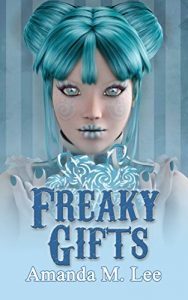 Freaky Gifts by Amanda M. Lee:
Freaky Gifts by Amanda M. Lee:
Winter break is upon Mystic Caravan, which is supposed to mean a full month of rest and relaxation. Upon arriving at their destination, however, Poet and company find that murder isn’t far behind.
Their off-season park is full of paranormals – something that normally makes Poet comfortable – but the death of a local girl points to one of their own being the culprit. Even though she’s supposed to be taking it easy, Poet can’t stop herself from digging … and it leads her on a wild ride.
Florida is hot, humid and bursting at the seams with supernatural friends. Unfortunately for Poet, it’s also home to an ex-boyfriend who can’t quite let go. Since he’s a police officer … and looking at Mystic Caravan’s cadre of weirdos as potential murder suspects … that only makes things all the more difficult.
It’s up to Poet to find the real culprit even as a shadowy and powerful figure stalks her. Kade’s magic is growing but he’s still learning, which makes for some hard battles. On top of that, he’s keeping a secret with Luke, which has Poet teetering on the edge of sanity.
It’s supposed to be a break, not a break from reality, but Poet is ready to fight for her future. It’s going to take everybody working together to figure out the truth … and give Poet the one thing she’s always wanted above all else.
Peace.
Over the years, Connor has pieced together evidence of a mysterious group of aliens who roamed the multiverse and have been to New Earth.
Setting off to make new discoveries about them is straightforward enough, but this is New Earth, and Connor Gates has a knack for finding trouble.
For over twenty years, Connor and Diaz have been friends. They’ve survived two wars and have seen the best and the worst of each other. When a terrorist attack takes the life of Diaz’s son, their friendship will be pushed to the breaking point.
To find who is responsible, Diaz is willing to cross as many lines as it takes. Connor will do everything he can to protect his friend, even from himself. It’ll take everything he’s got to find who is responsible while preserving a peaceful coexistence with New Earth’s inhabitants.
Sometimes protecting your friends is a lot tougher than fighting your enemies.
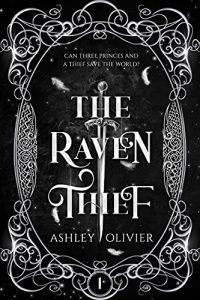 The Raven Thief by Ashley Olivier:
The Raven Thief by Ashley Olivier:
Enya has a few very simple goals in life.
Take down a tyrannical king, give her gang a decent life, become the leader of Skeyya’s rebellion, and maybe become slightly more rich along the way.
Okay, so maybe those goals aren’t so simple. And everything comes at a cost in the capital streets of Arden; King Eamon is after her head, and shadows lurk around every corner, waiting to spill secrets and blood.
After being captured and sentenced to death in the esteemed royal palace, Enya never expected to run into three princes who need her help—and especially not ones thought to be dead for over a decade. An impossible quest is proposed; an ancient evil is rising, and only they can stop it. The Crimson Witch, a faerie demon imprisoned in the Black Lake, along with her undead army of ghouls.
Enya has now found herself caught in a web of darkness and deceit as she guides these princes and her right-hand man, Carson, on a journey to track down the magical artifacts needed to take down the Crimson Witch once and for all.
Love, friendship, and bravery will all be tested. Can three princes and a thief save the world?
Ryan Hendrix is dead…
…Or so his family, his girlfriend, and his fellow Marines think.
Terribly wounded during the battle for Hermes, Ryan Hendrix was repaired with cybernetics, transformed into a weapon by Fleet Intelligence…and covertly dropped onto the enemy-occupied colony at Aphrodite to sabotage the enemy and build up a civilian resistance.
While Ryan fights the real battle behind enemy lines, Travis Miller and Jessica Leer struggle with politics…and their new commands. The Earth government is too scared of losing more cruisers to try to take back the occupied colonies, so Travis and Jessica find themselves stuck raiding enemy outposts, trying to draw their attention away so Ryan and the rest of his commandos can do their job.
But Travis Miller didn’t get to be the head of the largest task force in human history by sitting back and doing what he’s told. And when one of those raids turns up key intelligence, Travis will do whatever he has to in order to get back in the real fight.
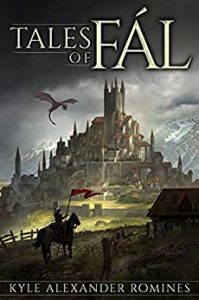 Tales of Fál by Kyle Alexander Romines:
Tales of Fál by Kyle Alexander Romines:
Welcome to the world of Fál.
A murderous outlaw confronts his past.
A princess has a monster at her mercy.
A desperate woman turns to a dark sorcerer for help.
A young magician learns to follow her heart.
An aging warrior makes his last stand.
Dive into a new fantasy world full of monsters and magic in the Tales of Fál, featuring over 500 pages of stories of heroes, villains, and everything in between.
An offer that no one else could match
A mission that no one else could achieve
An enemy only a few know they share…
Commodore Kira Demirci is now the commander of a small but powerful mercenary force—one of the most dangerous in the cluster of stars she now calls home. Her own actions have brought peace to the Syntactic Cluster, though, and a mercenary is in limited demand.
A mutual interest brings her into the circle of the heir to the Royal Crest, a wealthy kingdom dozens of light-years away. Jade Panosyan has a nightmare brewing—and a plan to deal with it.
In the Crest, a powerful political party beholden to Kira’s own enemies is maneuvering to remove Jade’s father before he can free a dozen star systems from the clutches of the Equilibrium Institute. If they are to fail and the Institute’s plans be thwarted once more, Jade Panosyan needs someone to complete an impossible mission.
The payment? The fleet carrier Fortitude, unmatched by any ship within a hundred light-years.
The catch? Kira Demirci has to capture the carrier—from the elite forces of her employer’s nation!
 Metal Warrior: Fist of Steel by James David Victor:
Metal Warrior: Fist of Steel by James David Victor:
Sometimes, your only option is to surrender to a higher power. Of course, that option usually isn’t very good either.
A military sci-fi adventure from Amazon All-Star author James David Victor
Humanity is in shambles and its defenses have been destroyed. With no other apparent options, the Council of Worlds decides to seek peace with the Exin. Sure that this can come to no good, Dane Williams and the remaining metal warriors set out on a desperate mission to make peace the only way that will truly work. To put an end to the Exin threat once and for all. Can Dane stop the unstoppable alien force or is humanity truly doomed?
Metal Warrior: Fist of Steel is the last book in the Mech Fighter series. If you like fast-paced space adventures with engaging characters and exciting battles, you will definitely want to see how the Metal Warriors save mankind, or if they can.
In a lush solarpunk future, plants have stripped most of the poison from the air and bounty hunters keep resource hoarders in check. Orfeus only wants to be a travelling singer, famed and adored. She has her share of secrets, but she’s no energy criminal, so why does a bounty hunter want her dead? Not just any bounty hunter but the Wolf, most fearsome of all the Order of the Vengeful Wild. Orfeus will call in every favor she has to find out, seeking answers while clinging to her pride and fending off the hunters of the Wild. But she isn’t the only one at risk: every misstep endangers the enemies she turns into allies, and the allies she brings into danger. There are worse monsters than the Wolf hiding in this new green world.
“It’s an inclusive, optimistic vision of the future, rounded out by beautiful imagery and an effortlessly diverse cast. This enthralling story is a winner.” Publishers weekly (starred review)
August 29, 2021
Indie Crime Fiction of the Month for August 2021

Welcome to the latest edition of “Indie Crime Fiction of the Month”.
So what is “Indie Crime Fiction of the Month”? It’s a round-up of crime fiction by indie authors newly published this month, though some July books I missed the last time around snuck in as well. The books are arranged in alphabetical order by author. So far, most links only go to Amazon.com, though I may add other retailers for future editions.
Our new releases cover the broad spectrum of crime fiction. We have hardboiled mysteries, cozy mysteries, historical mysteries, retro mysteries, Jazz Age mysteries, 1950s mysteries, 1960s mysteries, British mysteries, paranormal mysteries, crime thrillers, legal thrillers, psychological thrillers, occult thrillers, revenge thrillers, action thrillers, adventure thrillers, sea adventures, dystopian noir, police officers, private investigators, amateur sleuths, prosecutors, assassins, FBI agents, ex-CIA agents, ex-spies, organised crime, serial killers, con artists, terrorism, drug trafficking, human trafficking, satanic cults, crime-busting witches, crime-busting socialites, crime-busting surfers, crime-busting girl scout leaders, murder and mayhem in Los Angeles, London, New Orleans, Chicago, Southern California, Ohio, Iowa, Venezuela, Miami, Cornwall and much more.
Don’t forget that Indie Crime Fiction of the Month is also crossposted to the Indie Crime Scene, a group blog which features new release spotlights, guest posts, interviews and link round-ups regarding all things crime fiction several times per week.
As always, I know the authors at least vaguely, but I haven’t read all of the books, so Caveat emptor.
And now on to the books without further ado:
 The Fool on the Hill in a Convertible by Donna Amis Davis:
The Fool on the Hill in a Convertible by Donna Amis Davis:
It’s 1967. Beatles’ songs are playing everywhere.
In the sleepy little beach community of Mission Cove in Southern California, surfers search for the perfect wave, while across the Pacific, a war grinds on.
Torrey helps her dad and brother in the family’s surf shop, but her heart is full of pain. Her camera captures the beauty of the ocean and the joy of the surf, as it helps to soothe her soul. But on this day her camera ensnares her in a mystery she’d rather escape.
The Fool on the Hill in a Convertible is a cozy mystery novella introducing Donna Amis Davis’s new ‘60s Surf Shop Mysteries which are set in the fictional community of Mission Cove, California.
Journey back to the ’60s and relive that groovy era when skirts were short, hair was long, and the music was good.
 Murder on the Boardwalk by Beth Byers:
Murder on the Boardwalk by Beth Byers:
Vi and friends miss the sea and each other, so they gather up and head to the seaside. While there, they run into old friends and new troubles.
Once again, things turn sideways when a body is found by the boardwalk. All evidence points to the person they once knew almost as well as they know themselves. Is it possible their friend has turned to murder? Or is something else going on? Either way, they’re determined to find the truth. Even if it puts them into harm’s way.
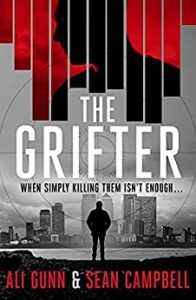 The Grifter by Sean Campbell and Ali Gunn:
The Grifter by Sean Campbell and Ali Gunn:
One will rise. The other will fall.
Kent Bancroft’s rise to fame and fortune was nothing short of meteoric. Once a simple teacher in London’s East End, he’s now on course to become Britain’s youngest billionaire.
But his success has come on the back of those he’s trodden upon to get there. Among them is a man whose fall was as swift as Kent’s rise. He used to be a sparky until a freak accident robbed him of one leg.
And then Kent Bancroft robbed him of everything else.
Forget forgiveness. Forget turning the other cheek. And forget waiting for karma.
This is a victim who won’t stand idly by.
He wants revenge.
And he’s going to get it.
Kent Bancroft will never see him coming.
Will Darling is all right. His business is doing well, and so is his illicit relationship with Kim Secretan–disgraced aristocrat, ex-spy, amateur book-dealer. It’s starting to feel like he’s got his life under control.
And then a brutal murder in a gentleman’s club plunges them back into the shadow world of crime, deception, and the power of privilege. Worse, it brings them up against Kim’s noble, hostile family, and his upper-class life where Will can never belong.
With old and new enemies against them, and secrets on every side, Will and Kim have to fight for each other harder than ever—or be torn apart for good.
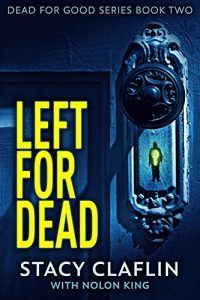 Left For Dead by Stacy Claflin and Nolon King:
Left For Dead by Stacy Claflin and Nolon King:
What’s an innocent assassin to do?
Brad Morris was just cleared of murdering one annoying neighbor when another one turns up dead. Luckily, he was at a party with everyone on the block when the body was found, but that doesn’t stop fingers from pointing his way. Especially since the murder weapon was a BlueBlade, the knife company that Brad’s boss, Kurt, uses as a front for the real work that Brad and his fellow assassins do.
Kurt demands that Brad find the real killer — without blowing his cover or dragging BlueBlade into the investigation. If he can’t, he’ll be thrown to the wolves. Or worse, “retired.”
Does one of Brad’s suburban neighbors hate him enough to frame him for murder? Or does he have a much more dangerous enemy lurking within the fellowship of assassins?
In New Babylon, leader of the Western alliance of the city-states, armament mogul Kurt Wagner has a secret dream: to build a space station to save mankind. Little does he know that he is the target of competing plots involving geopolitics and black magick. In the background, a film director with a political conscience, a bodyguard with a secret mission, a driver with an occult hobby and a talking bird are trying to make sense of their world, hoping to see their wishes come true – which they will, but not in the way they might have expected.
 My Brew Heaven by Lily Harper Hart:
My Brew Heaven by Lily Harper Hart:
Ofelia Archer should be riding high after a blissful week spent with her boyfriend Zacharias “Zach” Sully. Sun, fun, and cocktails make for a great break … until she gets home. Then she realizes exactly how far things can fall apart in only a few days.
It seems in her absence Ofelia’s mother Marie Charles has been taken in by a cult, and Ofelia is convinced it’s not the sort of group who worship beignets over chaos and bloodshed. When Ofelia tries talking to her mother she finds a different woman waiting for her … and she’s beyond concerned.
The French Quarter attracts weird people but this time the strife is different. When she starts digging, she finds more than she bargained for … and yet the answers are less than she was hoping for.
Ofelia is a witch with a plan but even she’s at a loss. When her brother Felix is hurt in the pursuit of reclaiming Marie, the Quarter’s favorite magical maven swears revenge … and she’s going to need Sully to help her deliver it.
Their new enemy is powerful and he’s hiding behind a gaggle of innocent humans. Freeing the French Quarter from his grip leads Ofelia down a dark path. Only Sully can help her … and together they will bring their city back from the brink.
The question is: Will they both survive to enjoy the fruits of their labor once they make it to the other side?
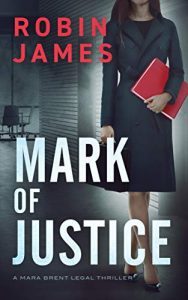 Mark of Justice by Robin James:
Mark of Justice by Robin James:
What he did to her…
As Maumee County, Ohio’s top prosecutor, Mara Brent has faced down killers before. But the murder of Haley Chambers is different. The evidence left behind at the crime scene paints a horrifying picture of Haley’s last hours. Her killer took his time. Planned. Hunted. Executed.
No one will believe it…
When local mechanic and family man, Cal Emmons is charged with the crime, the town rallies to his defense. Everyone knows him. Everyone trusts him. His supporters bring their protests right to Mara’s front door. But they don’t know. They haven’t seen what Mara and the police found at his house.
But there is one more victim out there…
The police connect physical evidence in Haley’s murder to a cold case abduction. Only that victim lived. Her harrowing, firsthand account of what she endured haunts Mara and provides a Rosetta Stone for Haley’s murder. But Mara’s star witness never saw her attacker’s face. She has lied to the police before. Is she lying now?
If Mara loses this one…more will die.
To win, Mara must ultimately step inside the mind of a sadistic killer. But this time when evil touches her, it may not let her go.
 Sons of Brutality by Daneil Jeudy:
Sons of Brutality by Daneil Jeudy:
A SATANIC SNUFF CLUB
A RUTHLESS VIGILANTE
AN INTRICATE WEB OF DECEPTION
WHO CAN YOU TRUST?
Los Angeles is a city under siege.
When Detective Addison Mowbray begins investigating the murders of two young women in the Hollywood Hills, he can’t imagine where the case will lead. He suspects the crimes were inspired by an occult fascination, due to some missing body parts and the inverted Christian cross branded on the victims’ breasts. But apart from Addison’s temperamental partner, Jed, the only other person keen on them pursuing that line of investigation is Lilly Coniglio, a medical examiner from the Coroner’s Department. The LAPD is already under immense public pressure due to all the bad press another killer – a vigilante – has brought to their door: it’s been over a year since the first organized-crime figure showed up full of holes, with a plastic police badge beside his body.
As Addison and Jed navigate a murky, disturbing occult landscape in search of answers, they uncover something even more terrifying than a killer hiding in the shadows: an organization so vile and powerful that it changes their lives forever. These two troubled detectives are all that stand between this organization and a spectacular season of carnage.
Set against a backdrop of urban bleakness and social inequality, Sons of Brutality combines deeply flawed protagonists with human monsters, integrating strong dialogue, violent action and gripping Suspense.
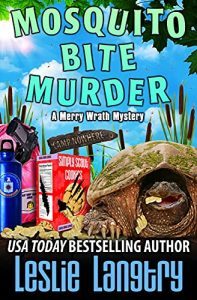 Mosquito Bite Murder by Leslie Langtry:
Mosquito Bite Murder by Leslie Langtry:
In her career as a spy, Merry Wrath had her share of camping trips—from glamping in a yurt at Oktoberfest with drug lord Carlos the Armadillo to an awkward team building campout in the backyard of a Yakuza mob boss who thought “trust falls” should have lethal consequences. So when the former CIA turned Girl Scout troop leader has the opportunity to take six girls from her troop into a vast, private nature preserve in search of an abandoned scout camp, she jumps at it. The fact that she can secretly use this as a chance to meet up with another spy who has asked for her help just seems to be an added bonus.
Of course she doesn’t expect to find a guy named Chad in a shallow grave. He’s still alive, at least for the moment, and he insists on accompanying them further into the woods. Merry’s contact is a no-show, but another, more dangerous colleague surprises them on the trail. And just when she thinks she might be able to handle things, the group find themselves confronted by a hostile group of senior citizen hermits.
From the strange noises in the night, to vampire ticks, and the constant fear of being invaded by Communists, everything in Merry’s world appears to be dangerously off kilter. When she’s accosted by a 200lb snapping turtle named Old Eisenhower, Merry realizes that not everything is what it appears to be. Can Merry figure it out who is behind the stranger occurrences before the camping trip ends up with a body count?
 Freaky Gifts by Amanda M. Lee:
Freaky Gifts by Amanda M. Lee:
Winter break is upon Mystic Caravan, which is supposed to mean a full month of rest and relaxation. Upon arriving at their destination, however, Poet and company find that murder isn’t far behind.
Their off-season park is full of paranormals – something that normally makes Poet comfortable – but the death of a local girl points to one of their own being the culprit. Even though she’s supposed to be taking it easy, Poet can’t stop herself from digging … and it leads her on a wild ride.
Florida is hot, humid and bursting at the seams with supernatural friends. Unfortunately for Poet, it’s also home to an ex-boyfriend who can’t quite let go. Since he’s a police officer … and looking at Mystic Caravan’s cadre of weirdos as potential murder suspects … that only makes things all the more difficult.
It’s up to Poet to find the real culprit even as a shadowy and powerful figure stalks her. Kade’s magic is growing but he’s still learning, which makes for some hard battles. On top of that, he’s keeping a secret with Luke, which has Poet teetering on the edge of sanity.
It’s supposed to be a break, not a break from reality, but Poet is ready to fight for her future. It’s going to take everybody working together to figure out the truth … and give Poet the one thing she’s always wanted above all else.
Peace.
GUY WALKS INTO A STRIP CLUB…
AND COMES OUT FILTHY RICH
Down-and-out comedian “Filthy” Rich wasn’t always living on the edge– he was once famous. Now he tells viciously dirty jokes in the seediest possible strip clubs–his routine is so filthy that it’s actually illegal, since 1960’s Chicago has harsh blue laws.
Rich wasn’t always living on the edge, though– he was once famous for a clean routine, until his estranged wife ran off with Rich’s best jokes. With his act missing, he’s hellbent on tracking down the missing dame before he gets caught spewing the grossest jokes this side of Lake Michigan.
Enter Lou Fleener– expert streetfighter and ace private eye. Rich hires Lou to find the missing jokes– and the wayward wife. Which seems easy enough, right? But unfortunately, Lou’s clues lead him down a perilous rabbit hole of deceit, lies, and frame ups.
Plus, the irrepressible Cassidy, his wife turned partner-in-crime, and Monk, his improbably handsome yet socially awkward best friend, are knee deep in their own rollicking thrillers. The whole team is in imminent danger, each facing their own bad guy. And to top it all off, this team of witty Chicago sleuths is flat broke. Again.
Lou Fleener will be a treasured read for both cozy lovers and hard-boiled aficionados. And especially for readers looking for laughs. Lou and his team’s humorous yet action-packed adventures that will please fans of such diverse authors as Donald Westlake, Raymond Chandler, and Lawrence Block in his “burglar” mode.
Ex-agent Eva Rae Thomas is on the run. The past month she has done things she never knew she was capable of while hunting for her kidnapped daughter.
Eva Rae has risked everything,
-her career,
-her newfound love,
-her freedom.
She’s looking for the man they call the Iron Fist. The trail has led her to Miami.
Meanwhile, Miami is under attack. Hundreds of passengers in the Metrorail are exposed to a deathly nerve gas on a peaceful Monday morning. When Eva Rae Thomas sees her daughter on the surveillance footage from the attack, she knows it is no coincidence. But by the time she uncovers the chilling truth of how it is all connected, it might be too late.
THE PERFECT ESCAPE…
Gabrielle Adams has it all – brains, beauty, a handsome fiance?, and a dream job in publishing. Until, one day, everything changes.
‘The Tube Killer’ takes his victims when they least expect it: standing on the edge of a busy London Underground platform, as they wait for a train to arrive through the murky underground tunnels of London.
Gabrielle soon learns that being a survivor is harder than being a victim, and she struggles to return to her old life. Desperate to break free from the endless nightmares, she snatches up an opportunity to run a tiny bookshop in a picturesque cove in rural Cornwall.
She thinks she’s found the perfect escape, but has she swapped one nightmare for another?
Suspense and mystery are peppered with romance and humour in this fast-paced thriller, set amidst the spectacular Cornish landscape.
 Steady As She Goes by Wayne Stinnett:
Steady As She Goes by Wayne Stinnett:
Jesse McDermitt is starting a new chapter in his life. As captain of the research vessel Ambrosia, his stated mission is to study the oceans and seafloor, searching for rich oil deposits. His unstated mission is to locate and eradicate the enemies of society on behalf of Armstrong Research, a secretive organization funded by some of the wealthiest people on the planet.
When word gets out about a massive drug and human trafficking cartel moving tons of illegal drugs, along with hundreds of slave laborers, out of Venezuela, Jesse is tasked with finding them at all cost.
But how can one man find the traffickers amid the thousands of ships coming and going from Venezuela’s ports, moving hundreds of thousands of containers every year?
Can Jesse close on and engage the traffickers in time to save dozens of innocent lives?
 Murder in London by Lee Strauss:
Murder in London by Lee Strauss:
Murder’s a trip!
It’s early 1957, and Rosa Reed and her new beau Detective Miguel Belmonte fly from California to London to follow up on the cold case: the murder of Rosa’s good friend Lady Vivien Everleigh.
The investigation is complicated, if not awkward, as the deceased is the sister of Rosa’s former fiancé. Thankfully, Rosa’s parents, Ginger (aka Ginger Gold of Lady Gold Investigations) and Basil Reed are there to help.
Rosa stumbles onto a dangerous truth. Can she find her friend’s killer and save her own life too?
If you love early rock & roll, poodle skirts, clever who-dun-its, a charming cat and an even more charming detective, you’re going to love this new series!
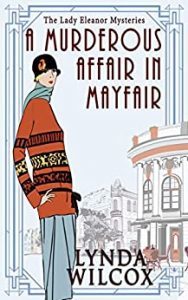 A Murderous Affair in Mayfair by Lynda Wilcox:
A Murderous Affair in Mayfair by Lynda Wilcox:
Private enquiry agent Lady Eleanor Bakewell returns in another tale of murder, intrigue, and romance set in 1920s London.
Who had the nerve to commit murder at an elegant high-society party in Mayfair?
Who among the other seven people playing cards that evening with Lord George Bancroft, notorious womaniser and gambler, pun a knife in his back?
Lady Eleanor Bakewell doesn’t know, but when a young parlourmaid ask for her help in proving her innocence, the socialite sleuth is soon on the case.
So, too, are Military Intelligence which puts a new and unwelcome angle on the case for Eleanor.
Mired in suspects and questions about the dead man’s background, Eleanor feels overwhelmed. She will need all her wits about her to find the killer before the parlourmaid is wrongly arrested for a crime she did not commit.
August 27, 2021
Retro Review: “The Green Huntsman” by Dorothea Gibbons

If this cover seems familiar, that’s because the artwork by Harold De Lay originally appeared on the cover of the January 1944 issue of Weird Tales.
“The Green Huntsman” is a gothic short story by Dorothea Gibbons, which was first published in the July 1954 issue of Weird Tales. The story may be found online here. This review will also be crossposted to Retro Science Fiction Reviews.
I came across this story, while I was reviewing “More Than Shadow” by Dorothy Quick and was intrigued that there were two other new stories as well as one new poem and a reprint by women writers in the same issue of Weird Tales, proving once again that Weird Tales was the most woman-friendly SFF magazine of the pulp era.
The name Dorothea Gibbons will not mean anything to most people. However, Dorothea Gibbons is a very well known author, probably one of the most famous mainstream authors ever to publish in Weird Tales next to Tennessee Williams as a sixteen-year-old debut author (and I should really review his debut story some day). For Dorothea Gibbons was none other than British novelist, poet and journalist Stella Gibbons, author of Cold Comfort Farm (which is absolutely genre, even if most people don’t realise it). As Dorothea Gibbons (her full name was Stella Dorothea Gibbons), she published three stories in Weird Tales in 1953 and 1954. None have ever been reprinted.
Warning: There will be spoilers in the following.
“The Green Huntsman” opens in the manor house of Scarth on a misty autumn morning dripping with gothic atmosphere. Here Richard Ayreton, lord of the manor, and his agent Nick Borrodale await the arrival of Ayreton’s niece Francesca Newtownly, a penniless war widow with a seven-year-old son.
So we have the classic gothic set-up of a young woman coming to a creepy manor, from which she will eventually run clad only in her nightgown, at least if the covers of gothic romances from the 1960s are to be believed. But first, Nick has to pick up Francesca from the train station. He’s instantly smitten with her, but also uneasy, because of something that haunts the nearby woods in autumn.
Nick warns Francesca and her son Paul not to go into the woods, so he won’t say why, because the truth would either terrify Francesca or worse, she wouldn’t believe it. So Nick males up a story about cutting down trees in the woods and that it’s too dangerous to go there. Francesca, however, isn’t having any of it. “If the men are felling trees, they’re very quiet,” she says.
Not long after, Nick gets a panicked message from Francesca that Paul and his dog Sebastian have gone missing and that Francesca fears they went into the woods. She also reveals that she knows that there was never any tree cutting work going on and begs Nick to tell her just what the matter is with those woods. Francesca also reveals that she’s been in the woods and saw something green watching her from between the trees.
Paul and Sebastian eventually reappear at the manor safe and sound. Paul confesses that he went into the woods, even though Sebastian with his canine instincts for the supernatural tried to stop him. Paul also sees something green among the dead trees. When he investigates, he realises that it’s a horseman clad all in green on a green horse. The horseman trains his hypnotic gaze on Paul and beckons him to come, but Sebastian, the heroic dog, intervenes and pulls Paul to the ground, saving the boy. When Paul looks up again, the green rider is gone.
Now Nick and Richard Ayreton finally share the story of the green huntsman with Francesca. It turns out that the huntsman was an evil man who hunted in those woods on a devilish horse hundreds of years ago and has been haunting the woods ever since, always appearing in autumn. According to legend, the only way to get rid of that evil spirit is when another four-legged creature will confront him to save a human life. And Sebastian, the faithful spaniel, saved Paul from the huntsman and thus exorcised the evil spirit for good.
This is a spooky gothic story that is dripping with atmosphere. The decaying manor and the misty, windswept woods are vividly described. The interior art by Virgil Finlay is also great.
I like that Francesca is not your average insipid gothic heroine who runs away from the spooky manor clad only in her nightgown. She never for a minute buys Nick’s weak excuse about men felling trees in the woods and also confronts him about it.
My main criticism about “The Green Huntsman” is that it’s way too short. After all the build-up, the confrontation with the evil huntsman is over in a few paragraphs. Furthermore, we don’t see it happening on the page, but hear it recounted by Paul after the fact.
Also, I would have liked more details about the history of the huntsman and why he does what he does. He was an evil man and now he and his evil horse haunt the woods after his death is a weak explanation. Surely, there must be more to the story. Did the huntsman develop a taste for hunting “the most dangerous game” or was he himself hunted by villagers with pitchforks and swore vengeance from beyond the grave? Inquiring minds would like to know.
That said, I did like the solution that what broke the curse was the heroic act of a cocker spaniel. After Dorothy Quick’s tale of an evil faery poodle, which appeared in the very same issue, this one makes a nice counterpoint.
The atmosphere and writing are great, but the story is flawed.
August 26, 2021
Fancast Spotlight: So I’m Writing a Novel
I initially started the Fanzine/Fancast Spotlight project to highlight Hugo-eligible fanzines, fansites and podcasts. For more about the Fanzine/Fancast Spotlight project, go here. You can also check out the other great fanzines and fancasts featured by clicking here.
The Hugo finalists for 2021 have long since been announced, but I want to keep the project going, because after the Hugo nominations is before the Hugo nominations. And besides, there are still a lot of great fanzines, blogs and podcasts out there that I haven’t covered.
So today, I’m pleased to feature the So I’m Writing a Novel podcast, in which the listeners can follow along as host Oliver Brackenbury writes a sword and sorcery novel.
And therefore, I’m happy to welcome Oliver to my blog today:
Tell us about your podcast or channel.
Well, as I like to say at the start of each episode:
“So I’m Writing a Novel is the show where you join me, Oliver Brackenbury, on the journey of writing my next novel, from first ideas all the way to publication & promotion.
In this one-man-reality show I’ll share with you my ever evolving thoughts and feelings on how I write, being a writer, and everything that entails at each stage of the process. I’ll also answer listener questions and, sometimes, interview people who write fiction.
If you’re the kind of person who likes to learn how things are made, and get to know the people making them, then this is the show for you.”
The novel is a sword & sorcery short story cycle, meaning it’s a bunch of short stories following a fifteen year period in my protagonist’s life. Each story can stand alone, but readers are rewarded for reading from first to last.
Similarly I do my best to make each podcast episode work in isolation, providing short recaps as necessary, but starting from the beginning and working your way up will yield greater rewards.
Who are the people behind your podcast or channel?
It’s all me, though I enjoy using a third person voice in posts and social media to suggest I control a vast multi-media empire. Maybe, if the Patreon really catches fire, one day I’d hire someone to edit this thing, but for now I like that I’m the only person I have to rely on to get it out into the world.
Why did you decide to start your podcast or channel?
Many reasons! The main thrust of the idea was figuring out a way to build an audience for a novel as I worked on it, so I could make myself more appealing to publishers and agents when I’m ready to start querying. But also…
I wanted to create a virtuous cycle where I need to work on the novel so I have something to talk about on the podcast, and talking about stuff on the podcast gets me excited to work on the novel. So far, it’s working well.A former Youtuber, I missed putting something out regularly online but really just wanted to talk with people…and boy is the workload lessened by not having to worry about visuals!I also missed regularly meeting and interacting with strangers through my work. Please holler at me on Twitter (@so_writing) or submit a listener question to soimwritinganovel@gmail.com, I love it! I’m also down with guesting, or guest hosting, on other people’s podcasts. I’m an extrovert living in a pandemic, help!I was frustrated at not having more money to invest in my writing, or in the work of other artists (boy do I want to commission original illustrations for the book). Thus, the Patreon I launched alongside the podcast (patreon.com/soimwritinganovel).I was starting to have a strong negative reaction to the never-ending glut of writing advice online. Basically I was fed up with overly positive and overly negative voices, listicles, absolutism, “this is what all writers must do in all circumstances, from now until the end of time” stuff…This made me want to put something out that I would enjoy listening to. Thus my framing the podcast as a highly transparent sharing of my writing journey, my constantly evolving process and where I’m at in any given moment, being spoken from one peer to another, as opposed to a speaker standing on a stage or at a podium. I also do my best to keep the tone in a sweet spot of being positive, but not saccharine, honest and open, but not oversharing or maudlin.
I could easily add a few more reasons. This project really burst out of me!
What format do you use for your podcast or channel and why did you choose this format?
I’m lucky to have opening and closing music composed by the marvellous Gloria Guns (gloriaguns.bandcamp.com/). After the music, I run through my show intro about what the show is, briefly mention what the previous episode covered, then dive into that week’s subject. Discussing that makes up the bulk of the episode and then, if I have one, I’ll answer the listener question before going into an outro of sorts where I encourage people to submit questions, share the show, sign up with the Patreon etc. Then it’s the final music and we’re out! Regular episodes average 30-45 minutes in length, while interviews hew closer to the 60 min mark.
I choose subjects as they relate to my progress in working on the novel, so in the first episode I talk about the short story which bloomed into the novel project, in episode two I cover my protagonist, and so on. The order of episode subjects doesn’t perfectly match the order of what I worked on in my project notebooks, because often what made the most sense for my brain in working on the book would be a it of a mess for presentation to another human being.
I also strongly encourage those who submit questions to record their question on their phone and send the audio file to soimwritinganovel@gmail.com Then I can cut it into an episode just like a radio call in show, which I love.
I came to this format through recording three and a half different versions of the first episode, getting feedback from trusted pals at each stage, and then sticking with something that felt right.
Interviews happen semi-randomly, for now. I want to use them to break things up now and then, which serves a few purposes, including giving listeners a chance to hear a voice other than my own.
For my release schedule, I do a weekly release on Mondays, and Patreon supporters get to listen to new episodes a week early, as well as a second, bonus podcast called So I Wrote a Novel where I read a chapter at a time from past works, providing “DVD commentary” at the end. I chose this because it felt like a good balance between building momentum for the show and burning myself out. I also needed to balance making the show with writing the dang novel I’m discussing!
It’s probable the release schedule, maybe even the format, will change when I finish outlining the novel and move to writing the first draft. I expect there will be less to discuss for a stretch, then lots to say when the first draft is one, and again when I’m working with a story editor to polish it. So if I switch to bi-weekly or even “When it happens” for certain periods, then go back to regular, weekly updates when it makes sense to do so, that’s fine by me. One lesson I’ve learned both as a former Youtuber and a consumer of various regularly updating things online is that shackling yourself to a specific schedule or format is a great way to eventually produce pretty mediocre stuff, burning yourself out, just to keep the #content spice flowing. I think it’s better to be fully transparent with your audience and just say “Things are gonna change for a bit, here’s how.”, especially when it costs nothing to remain subscribed to a podcast, Youtube channel, or whatever.
Boy this answer is too long. Let’s make it longer! I’ll also say that technically I’m releasing this show in seasons, because if this experiment works out then I imagine I’d do a second season all about the creation of the next novel. But we’ll see!
The fan categories at the Hugos were there at the very beginning, but they are also the categories which consistently gets the lowest number of votes and nominations. So why do you think fanzines, fancasts and other fan projects are important?
Well, where the heck are creators (and the multi-media conglomerates that feed off them) without fans? Going all the way back to things like Amra and beyond – wasn’t there a Sherlock Holmes fan group or fifty back in the Victorian age? They must have made some things. – fans have wanted to create works inspired by what they love, and connect with each other. Hell, I’m sure there were some papyrus fanzines going around Ancient Egypt.
Point being that I think fan culture can be unfairly tagged as being ephemeral, but really it’s not and it is important if only for the long history it has, as much as the vital role in supporting creative works and nurturing various social scenes for people to connect with one another.
It’s funny, I have a few friends that voraciously post about their fav bands. I am not into these bands, but I am into how into these bands they are, if that makes sense? As long as it’s expressed in a non-toxic way, passion is inspiring and life-affirming! Ultimately it’s that raw energy that makes fanzines, fancasts, and other fan projects important, I reckon.
In the past twenty years, fanzines have increasingly moved online and fancasts have sprung up. What do you think the future of fan media looks like?
I’m the guy who thought Google wouldn’t take off as a search engine because “It’s such a dumb name.” and that bottled water wouldn’t take off because you can get water free from a tap. I might not be the best guy to ask about the future! I won’t say what will happen, but I do hope that we see further powerful strides forward in making fan culture even more inclusive. There’s still work to be done, for sure, but I’m amazed at how different it all feels compared to even just ten years ago.
The four fan categories of the Hugos (best fanzine, fan writer, fan artist and fancast) tend to get less attention than the fiction and dramatic presentation categories. Are there any awesome fanzines, fancasts, fan writers and fan artists you’d like to recommend?
I’m a big fan of the Turnip Lanterns newsletter by Angeline B. Adams and Remco Van Straten. It’s not dedicated to any one specific fandom, it’s more about what inspires and influences them as writers. However if you’re a fan of sword & sorcery, you can count on a good amount of content related to that genre on account of them having written the excellent The Red Man and Others (a new wave S&S novel, one I’d highly recommend). You can read about, and sign up for, it here: https://turniplanterns.wordpress.com/2021/03/22/newsletter/ It also comes in blog form, if you prefer – https://turniplanterns.wordpress.com
Where can people find you?
Search for “So I’m Writing a Novel” everywhere good podcasts are found and it should come up. There’s also the website at www.soimwritinganovel.com, @so_writing on Twitter, www.patreon.com/soimwritinganovel on Patreon, and there’s also a Ko-Fi at https://ko-fi.com/soimwritinganovel.
Finally, there’s a Twitch channel where I’ve done some early experiments with writing streams, found at https://www.twitch.tv/soimwritinganovel. I’m getting better at the technical side, and expect I’ll be doing a lot more there when I get to writing the first draft of the novel.
Thank you, Oliver, for stopping by and answering my questions.
Do check out So I’m Writing a Novel, cause it’s a fine podcast.
***
Do you have a Hugo eligible fanzine/-site or fancast and want it featured? Contact me or leave a comment.
August 24, 2021
Retro Review: “More Than Shadow” by Dorothy Quick

If this cover seems familiar, that’s because the artwork by Harold De Lay originally appeared on the cover of the January 1944 issue of Weird Tales.
“More Than Shadow” is a horror short story by Dorothy Quick, which was first published in the July 1954 issue of Weird Tales. The story may be found online here. This review will also be crossposted to Retro Science Fiction Reviews.
Warning: There will be spoilers in the following.
The protagonist of “More Than Shadow” is Mona, a wife and mother of three. Mona lives in a suburban house with her lawyer husband Hal, the children Carol, Meg and Harry Jr. and the housemaid Ellen.
At first glance, Mona would seem to have a pretty cushy postwar life. However, her 1950s domestic bliss is interrupted by strange occurrences that keep happening in her house. Cause whenever someone spills some kind of liquid – milk, tea, water – the liquid coalesces into a puddle shaped like a cuddly little dog. As hauntings go, this one is certainly creative.
The first two times it happens, Mona dismisses the dog-shaped puddles as a coincidence. By the third time, however, Mona realises that there is something very strange going on in her house.
Just to make sure that she isn’t imagining things, Mona calls over Ellen, the maid, and asks her what she sees in the puddle of spilled water. Ellen confirms that the puddle looks like a dog, but not just any old dog either, but the little dogs on which the leprechauns ride on moonlit nights. For Ellen just happens to be Irish and therefore a fount of Irish folklore.
Intrigued, Mona asks where the leprechauns go on those little dogs. A little spooked, Ellen, who – being Irish – of course believes in leprechauns, replies that no one really knows, but that according to legend the little dogs carry the leprechauns over the mountains to the land of youth.
The legend is familiar to Mona, because it reminds her of a quote about the land of faery from the 1894 play The Land of Heart’s Desire by William Butler Yeats, which is extensively quoted in the story, copyright apparently being no issue in 1954.
I’ve remarked before that for supposedly disposable trash fiction for the masses, the pulps were quite literary at times and are often full of literary references and allusions, many of which are not immediately recognisable to the modern day reader, even if they likely were to a golden age audience.
Unlike other authors of the era, Dorothy Quick does not assume that all readers will be familiar with the play (or have Google at hand to look it up), so she briefly has Mona sum up what the play is about, namely a newlywed bride being enticed by a faery child to come with her to the land of heart’s desire. The bride eventually succumbs and promptly dies in the real world.
Dorothy Quick also offers up a reason why Mona is familiar with the play, since she isn’t simply a fount of random Yeats quotations. For it turns out that Mona’s high school graduation class performed the play and that Mona played the doomed bride. More importantly, the night of the premiere of the play was also the night that Mona’s husband Hal, then still a young college freshman, proposed to her.
Seeing the dog-shaped puddle not only brings back memories of that long ago school play, it also reminds Mona that at the time, she wondered whether getting to live in the land of faery, forever young and carefree, wasn’t worth losing your life and soul for. Now, many years later, Mona feels the longing for the land of faery again, but she quickly dismisses it. After all, she’s happy, isn’t she? She’s got a great husband, three wonderful children, a beautiful home. She’s living the dream.
About a week after the incident with the dog-shaped puddle, a real dog comes into Mona’s life, when her kids find an adorable black poodle just sitting by the garden gate. Naturally, the kids want to keep it. Mona and Hal are quickly won over, though they caution the children that the dog probably already has an owner and just got lost. But until the legitimate owner shows up, the kids may keep it.
However, no previous owner appears and so the family keep the poodle, whom they name Jet, because he was jettisoned. The whole family loved Jet, only Ellen the maid is wary of the dog and insists that there is something strange about him. Being Irish, Ellen is apparently more sensitive towards the supernatural.
Whenever Mona cuddles with Jet, she has visions of Yeats’ land of heart’s desire, visions that are so vivid and realistic that she worries she might be going mad. When she confesses her worries to Hal, her husband admits that being with Jet makes him want to abandon his work and just go fishing all day long. However, Hal, being the rational type, believes that the presence of Jet simply loosens their inhibitions.
One day, while Mona is napping (Mona naps a lot), Jet cuddled up beside her, she hears strange music, as if in a dream. Jet suddenly starts talking and tells her that he can take her to the land of heart’s desire, where no one ever grows old and there’s only happiness, no pain. Jet also suddenly grows to the size of a small pony, big enough to ride upon. Jet tries to entice Mona to climb on his back and come with him to the land of heart’s desire. Mona is sorely tempted, but then she looks into Jet’s eyes and sees an ancient evil there. She also noticed that Jet has very sharp teeth, like fangs. But the temptation is stronger and Mona is just about to climb into Jet’s back and ride away, when her children burst into the bedroom, the otherworldly music stops and Jet shrinks to normal size.
Mona dismisses the whole incident as a nightmare. She tells Jet to play with the children and gets dressed – in a Dior taffeta gown – for a date night with Hal. Mona also realises that she has everything she ever wanted and that she would never give up Hal and her family, not even for eternal life and eternal bliss, even if it took her a nightmare to realise this.
When Mona and Hal return from their night on the town, they’re met by a panicked Ellen who tells them that their youngest daughter Carol and Jet the dog have both vanished. The two older children last saw Carol playing with Jet in a corner of the garden.
Hal wants to call the police, but Ellen – being Irish and therefore superstitious – insists that the police won’t be able to help, because the faeries have taken Carol and Jet was their emissary. After all, it is May Eve a.k.a. Walpurgis Night a.k.a. Beltane, when the little people have power. Ellen also tells Mona and Hal that some neighbours saw a happy and laughing Carol riding on a black poodle the size of a pony.
Hal, being the rational type, dismisses Ellen and her Irish superstitions, but Mona knows better. The nightmare she had was no dream after all. Jet really did grow to the size of a pony and when he couldn’t entice Mona to come away with him, he took her daughter Carol instead.
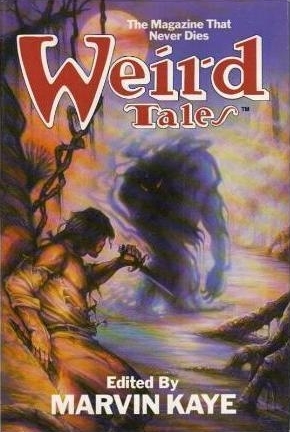
In 1988, “More Than Shadow” was reprinted in the anthology “Weird Tales: The Magazine That Never Dies”.
“Away with the faeries” stories are dime a dozen, but Dorothy Quick manages to put a new spin on that old familiar tale. Indeed, my initial impression of “More Than Shadow” was, “This is atmospheric and well written, but also really predictable.” Because Mona is your stereotypical 1950s suburban housewife who seems to be suffering from what Betty Friedan would eventually term “the problem with no name”. Indeed, Mona’s frequent naps seem to point at depression. And it was clear to me with my twenty-first century expectations of what stories about suburban housewives in the 1950s were like that Mona would go away with the faeries in the end, leaving behind her husband and kids, just like Lucy Jordan from the eponymous song. It was also clear to me that “away with the faeries” was probably intended to be a metaphor for the many real life 1950s suburban housewives who descended into alcoholism and substance abuse.
However, that is not the story that Dorothy Quick wrote. For while Mona is sorely tempted by Jet and his promises of the land of eternal youth and joy, she resists the temptation in the end. And what brings her back from the brink are her three children. Furthermore, the incident with Jet helps Mona to realise that she is happy with her life. She loves her husband and she loves her children and does not want to give them up for vague promises of eternal youth in the land of heart’s desire. And so in the end it is her daughter Carol – who’s only three years old and not able to consent – who is taken away to the land of faerie.
Considering how many portrayals of unhappy suburban housewives in the postwar era there are – from Betty Friedan via Lucy Jordan to Betty Draper – it is refreshing to see a suburban housewife who is not unhappy. For while there were many unhappy marriages and depressed housewives in the 1950s, there also were many women who loved their husbands and children and were happy with their suburban existence, though these women are often forgotten today.
Besides, Mona really does not have any visible reasons to be unhappy. Her husband Hal is no philandering Don Draper nor a permanently absent workaholic in a grey flannel suit nor is he abusive. Indeed, Hal is portrayed as kind and supportive throughout. He does not yell or complain when the kids or Mona spill something on the carpet (and one of the dog-shaped puddles is caused by a cup of tea that Hal spills), he does not dismiss Mona as hysterical, when she confesses her dreams of the land of faerie to him and he’s clearly still in love with his wife after several years of marriage. Okay, so Hal does not believe that the faeries took his daughter, but I don’t think we can blame him for that. Indeed, one thing I’ve noticed in all of the Dorothy Quick stories I’ve read is that Quick always portrays supportive and loving relationships. Even if the central couple dies horribly, as in the two Patchwork Quilt stories I reviewed last year, the relationship is still supportive.
Another thing that sets Dorothy Quick apart from other writers of the pulp era is that her stories always pass the Bechdel Test, something that is extremely rare during the golden age, even in stories by female writers. “More Than Shadow” is no exception and passes due to a scene of Mona talking to Ellen about leprechauns as well as several moments of Mona talking to her daughters.
What also strikes me about Dorothy Quick’s stories are her detailed descriptions of clothes, fabrics and interiors. Again, this is most notable in the Patchwork Quilt stories, where pieces of fabric trigger a kind of mental time travel. But “More Than Shadow” is also rich with description, whether it is Mona’s blue satin bedspread, her Dior taffeta gown with a bell-shaped skirt or the lacy negligee Mona wears in the scene where she is almost tempted to go away with Jet.
A cute little black poodle as an agent of evil and temptation may be unexpected, but there is a precedent. For in Johann Wolfgang von Goethe’s take on the Doctor Faustus legend, Mephistopheles initially appears to Faust in the guise of a black poodle. Was Dorothy Quick familiar with Goethe’s Faust? I have no idea, but it is not unlikely.
“More Than Shadow” is a neat little spooky story with an unexpected twist. The story appeared in the penultimate issue of the original run of Weird Tales, proving that the quality remained high until the end, even if half of the July 1954 issue of Weird Tales consists of reprints from earlier years of the magazine. Recommended.
August 15, 2021
My Story “We need to talk…” is Now Available at the Simultaneous Times Podcast
If you’re in the mood for some audio fiction, you can now listen to my humorous science fiction story “We need to talk…” in episode 42 of the Simultaneous Times podcast along with “Absolution” by Douglas A. Blanc and “Control Voice Blues (with apologies to The Outer Limits)” by Jean-Paul L. Garnier.
Simultaneous Times is a fiction podcast produced by my friends of Space Cowboy Books, a science fiction bookstore in Joshua Tree, California. Space Cowboy Books recently reopened for in-person business after more than a year of pandemic enforced closure. So if you’re in the area, pay them a visit and pick up some books.
“We need to talk…” was first published in my collection Bug-Eyed Monsters and the Women Who Love Them and is about a young woman trying to explain to the bug-eyed monster who abducted her that this relationship has no future.
The story is read by Zara Kand – the narrator is a woman, so this one really needs a female voice – with music by Phog Masheen.
Anyway, give it a listen and also make sure to listen to Douglas A. Blanc’s and Jean-Paul Garnier’s stories as well. You can listen on podomatic or right here:
August 12, 2021
The 2021 Dragon Award Finalists Take Another Big Step Towards Mainstream Respectability
As always in August, when you’re busy with other things, the finalists for the 2021 Dragon Awards, have been announced. The Dragon Awards are a fan award given out by Dragon Con, a massive SFF media con in Atlanta, Georgia.
This is only the sixth year of the Dragon Awards, but they have gone through quite a bit of history since then, as recounted here by Camestros Felapton. You can also find my previous posts about the Dragon Awards and their tangled history here.
The finalists for the 2021 Dragon Awards were announced today and the ballot looks pretty good with hardly any WTF? finalists and a lot of popular and well regarded works. This confirms a trend that we’ve seen in the past two years, namely that the Dragon Awards are steadily moving towards the award for broadly popular SFF works that they were initially conceived to be, as the voter base broadens and more people become aware of the award, nominate and vote for their favourites. It’s a far cry from the early years of the Dragon Awards, where the finalists were dominated by Sad and Rabid Puppies, avid self-promoters and Kindle Unlimited content mills with a few broadly popular books mixed in.
So let’s take a look at the individual categories:
Best Science Fiction NovelWe have a range of broadly popular novels here, though they tilt more towards hard SF than the Hugos are Nebulas normally do. Machine by Elizabeth Bear is one of those good SF novels that made neither the Hugo nor the Nebula ballot, so I’m glad to see it recognised here. A Desolation Called Peace by Arkady Martine is the sequel to the popular and Hugo winning (and excellent) A Memory Called Empire. Ernest Cline, Cory Doctorow, Andy Weir and Kim Stanley Robinson are all popular authors, so I’m not surprised to see them nominated, though personally I don’t care for their work (and no, it’s not because they’re male, but because I don’t care for their flavour of science fiction). The Ministry for the Future by Kim Stanley Robinson is also a book whose absence from the Hugo ballot surprised many, so it’s good to see it recognised elsewhere. And the pop culture and gaming focus of Ernest Cline’s fiction seems ideally suited to the Dragon Con crowd. The only surprise in this category is Black Sun by Rebecca Roanhorse. Not because it’s not a good or popular novel – it absolutely is (and also coincidentally the only finalist in this category that’s also on the Hugo ballot), but because it’s unambiguously fantasy. This is clearly a case of “The Ways of the Dragon are inscrutable”.
Diversity count: 2 women, 4 men, 1 writer of colour, 1 international writer*
Best Fantasy Novel including ParanormalHere we have another selection of broadly popular books. Jim Butcher and Brandon Sanderson are both massively popular, so I’m not at all surprised to see the latest books in their respective series here (and in fact, I’m surprised that the Dresden Files didn’t get a Best Series nod at the Hugos this year). Butcher is also a Dragon Con regular. Piranesi by Susanna Clarke is one of the most discussed fantasy novels of 2020 and has also been nominated for every award under the sun, so it’s no surprise to see it on the Dragon Ballot. The Invisible Life of Addie LaRue by V.E. Schwab and Once and Future Witches by Alix E. Harrow are two more highly regarded and popular novels. Charles Stross is another one of those authors whose work is not to my taste, but he’s popular and has also been nominated for a Dragon Award before.
Diversity count: 3 women, 3 men, 2 international writers
Best Young Adult/Middle Grade NovelThis is another very good ballot. A Wizard’s Guide to Defensive Baking by T. Kingfisher, Elatsoe by Darcie Little Badger and A Deadly Education by Naomi Novik are all popular YA novels (even though Naomi Novik’s novel was marketed as adult fantasy), which are also on this year’s Lodestar ballot. I also enjoyed both A Wizard’s Guide to Defensive Baking and Elatsoe very much, A Deadly Education less so. The Scapegracers by Hannah Abigail Clarke got a lot of buzz, when it came out earlier this year. Jeff VanderMeer is better known for his adult SFF, but his foray into YA A Peculiar Peril got good reviews. The only real surprise in this category is he Tinderbox: Soldier of Indira by Lou Diamond Phillips. Of course, I know Lou Diamond Phillips as an actor, but until today I didn’t know that he also writes YA SFF.
Diversity count: 3 women, 2 men, 1 non-binary, 2 writers of colour
Best Military Science Fiction or Fantasy NovelThis is still the category which looks most like the early years of the Dragon Awards and is dominated by Baen Books and indie publishers. It’s also the only all male category. But then, military SFF is a rather conservative subgenre, which is heavily dominated by Baen and indie books. Marko Kloos, Christopher Ruocchio and Larry Correia are all popular authors, though I’d classify Christopher Ruocchio’s Sun Eaters series as space opera or science fantasy rather than military SF. Larry Correia’s co-author John D. Brown was unfamiliar to me. He appears to be mainly a thriller author, but has also written epic fantasy. Walter Jon Williams is one of those great, but perpetually underappreciated authors. Plus, he writes military SF that I actually enjoy, so I’m thrilled to see Fleet Elements here. Rick Partlow, Jonathan Brazee and J.N. Cheney are all popular indie authors of military SF. Sentenced to War by Jonathan Brazee and J.N. Cheney also has a striking cover, which is a far cry from the usual exploding spaceships in space covers that dominate this subgenre.
Diversity count: 8 men, 1 writer of colour, 3 indie writers
Best Alternate History NovelWhile the military SFF category still looks very much like the early days of the Dragon Awards, the alternate history category looks a lot more mainstreamy these days. S.M. Stirling and Eric Flint (plus co-author Charles Gannon) are highly popular alternate history authors and frequent Dragon finalists in this category, even if their work is not to my taste. Mary Robinette Kowal’s The Relentless Moon is the third novel in her popular Lady Astronaut series and also a double Hugo finalist (for Best Novel and Best Series) this year. Lindsay Ellis is a popular YouTuber and also a finalist for the Astounding Award this year. P. Djèlí Clark is one of the most exciting newer voices in our genre and I’m very happy to see his alternate history mystery novel Master of Djinn nominated here. Charlaine Harris, finally, is the sort of author for whom the Dragon Awards were made, hugely popular, but overlooked by the Hugos and Nebulas, because most of her works are in series and in subgenres like urban fantasy or here alternate history that don’t get a lot of attention elsewhere.
Diversity count: 3 women, 4 men, 1 author of colour
Best Media Tie-in NovelThis category is a mixed bag this year and also demonstrates the broad spectrum of media tie-in novels these days. There are two Star Wars novel, including one by Timonthy Zahn, a Firefly novel, a World of Warcraft novel, a Warhammer 40000 novel and a tie-in novel for the new MacGuyver series. Fans of the latter apparently ran something of an online campaign to get it nominated (which is perfectly acceptable in the Dragon Awards), as Doris V. Sutherland found out. Interestingly, I couldn’t find out anything about Eric Kelley, one of the two co-authors of the MacGuyver novel (the other co-author is Lee Zlotoff, creator of MacGuyver) except that someone with the same name has written several cook books.
Diversity count: 1 woman, 6 men, 2 international writers
Best Horror NovelThe horror category at the Dragons has generally been very good (we will forget the first year, where a misclassified religious space opera novel won) and 2021 is no exception. The Only Good Indians by Stephen Graham Jones has already won every horror award there is to win, so it’s only fair that Jones gets a crack at a Dragon as well. Paul Tremblay is another very popular horror author and a regular on horror awards ballots. T. Kingfisher makes her second appearance on this year’s Dragon ballot with her horror novel The Hollow Places. T. Kingfisher a.k.a. Ursula Vernon is a perennial favourite of Hugo nominators, but it’s good to see her popularity extend to the Dragon Awards as well. Michaelbrent Collings is a popular indie horror author, though his nominated novel Synchronicity appears to be a science fiction thriller rather than horror. True Story by Kate Reed Perry received a lot of acclaim, when it came out last year. However, it appears to be a thriller rather than a horror novel. The Taxidermist’s Lover by Polly Hall is a modern gothic novel that also seems to have gotten a lot of acclaim.
Diversity count: 3 women, 3 men, 1 writer of colour, 1 international writer, 2 indie writers
Best Comic BookHere we have another category full of popular finalists. Monstress, Invisible Kingdom and Once & Future are all Hugo finalists this year as well and very good. Meanwhile, X-Men, Immortal Hulk and Daredevil hold up the flag for traditional (Marvel) superhero comics. DC is not represented, which is interesting.
Diversity count: 3 women, 9 men, 5 creators of colour, 9 international creators
Best Graphic NovelThis category is a truly mixed bag, but looks very good overall. We have a traditional superhero collection with Green Lantern: Season Two, a comic tie-in to Lev Grossman’s popular Magicians series, Pulp, a great graphic novel about a pulp writer who gets drawn into his own stories, that was also on my Hugo ballot this year, Dracula, Motherf**ker, a psychedelic horror comic about Dracula and his brides reappearing in 1970s California, which sounds actually awesome, The Magic Fish, a sweet story about a Vietnamese-American kid and his magic fish and The Book Tour, a surreal graphic novel.
Diversity count: 3 women, 9 men, 2 creators of colour, 5 international creators
Best Science Fiction or Fantasy TV SeriesThis category is full of popular TV and streaming series. WandaVision and Loki both made a big splash and were also hugely popular, though I’m a bit surprised that The Falcon and the Winter Soldier is missing. The Expanse and Star Trek Discovery are both perennial favourites in this category. The Nevers got some bad press, largely because of various unsavoury revelations about showrunner Joss Whedon, though most people seem to have enjoyed the series itself (and Whedon is out as showrunner anyway). Resident Alien was somewhat under my radar and seems to be more of a cult hit. Shadow and Bone surprises me a little, because not a lot of people seem to have enjoyed this YA fantasy adaptation. But then, it might be popular with Dragon Con’s younger members. Notable by its absence is The Mandalorian, but then there are a lot more good SFF TV series than slots.
No diversity count, too many people are needed to make TV series
Best Science Fiction or Fantasy MovieConsidering that theatres were closed during much of the eligibility period, this is a surprisingly strong ballot. Better than the Best Dramatic Presentation Long ballot of the Hugos IMO. Due to the pandemic, there hardly were any superhero movies this year, but Wonder Woman 1984 and Zack Snyder’s director’s cut of Justice League hold up the superhero flag here. Regarding the nomination for Snyder’s take on Justice League, I wonder whether to treat director’s cuts as new movies or re-edits. The Dragons obviously went for option 1, while I would have gone with 2. I enjoyed The Old Guard, which is basically an updated take on Highlander with a bad arse Charlize Theron and the world’s sweetest and deadliest gay couple, a whole lot, so I’m very glad to see it here. Tenet was one of the few bigger movies to actually come out last year, so it’s no big surprise to see it here, even if Christopher Nolan has never made a movie that I like. Bill and Ted Face the Music is the belated sequel to a beloved series and also a very sweet movie. In fact, I’m surprised that the Hugos overlooked it. Godzilla versus Kong has two big monsters fighting each other, so what’s not to love? The South Korean space opera Space Sweepers is a bit of a surprise, since it’s a smaller film and subtitled, too. However, it’s also delightful, so I’m happy to see it here.
Diversity count: 2 women, 5 men, 3 directors of colour, 2 international directors
The Gaming CategoriesI’m still not a gamer, so I can’t say much about these categories. I have heard of most of the PC/console games. I’ve seen ads for the Harry Potter: Puzzles and Spells mobile game, which were bloody annoying. I’m also fascinated that there apparently is a mobile game based on George Orwell’s Animal Farm. And Peer Sylvester, who’s a boardgame designer, points out that half the finalists in the board game category are not actually SFF.
All in all, the Dragon Awards continue to improve and are moving increasingly towards what they were supposed to be, namely an award for broadly popular SFF works. This is partly due to Dragon Con paying more attention to the awards and promoting them more to their audience as well as due to effforts such as the crowdsourced Dragon Awards eligibility spreadsheet created by the Red Panda Fraction.
The Dragons have also become a lot more diverse. There’s only one all male category and plenty of international writers and writers of colour are represented.
I still wish the Dragons were more transparent with regard to how many nominations and votes were cast and who the administrators are, but they’re on the right track.
ReactionsSo let’s take a look to the reactions to this year’s Dragon Award finalists, especially among those quarters who used to consider the Dragons Awards their territory.
Camestros Felapton, who along with Doris V. Sutherland and myself, has probably written the most about the Dragon Awards without wanting to win one, shares his thoughts on the 2021 ballot here. There’s also some discussion going on in the comments.
Over in Puppyland, Larry Correia is happy to be nominated for a Dragon Award together with his co-author John D. Brown and also has some praise for the rest of the category. He has little to say about the other categories, except those where friends of his are nominated.
Declan Finn, who has been talking up his preferred works of SFF for the Dragon Awards for several years now, shares his thoughts on the 2021 Dragon Award finalists and mostly demonstrates his complete and utter ignorance about contemporary SFF.
A friend of this blog who shall remain unnamed (because he hates being named and mentioned, since that is somehow silencing him) shares his thoughts on the 2021 Dragon Awards finalists and also shares what he voted for. Like Declan Finn, he found nothing to vote for in multiple categories.
Doris V. Sutherland has also dug up a couple of reactions from puppy adjacent folks on Twitter.
The Choices on the Dragon Awards 2021 Setup.
Gonna be honest: I will be leaving picks blank. Too much Pop Cult in here as well. /1 pic.twitter.com/lK1KsMwxue
— Fiannawolf, Questing for the Superversive. (@Fiannawolf2) August 12, 2021
So are the Dragon Awards officially a joke yet?
— The Most Athletic Voice In Science Fiction???? (@YakovMerkin) August 12, 2021
I did get two of my choices, but in niche categories. The rest is just slush…even the Baen stuff. A couple decent choices, but the votes are for the least offensive in the category than the outright good.
— PulpArchivist (@ArchivistPulp) August 12, 2021
Of course, what’s really happening here is not that the Dragon Awards have become a joke – in fact, they’re much less of a joke now than they were when they started – but that the Dragons better reflect the broad spectrum of SFF fandom and its tastes. And it’s notable that even the puppy and puppy adjacent commenters still found works to vote for.
*International writer means “not from the US” in this context, so British and Canadian writers count as international.
August 3, 2021
Eternia Revisited – Some Reflections on Masters of the Universe: Revelation
Like everybody who was a kid in the early 1980s and had access to US cartoons, I watched the original He-Man and the Masters of the Universe series. Though I was lucky, because the “access to US cartoons” part was not a given in the three TV channel world of 1980s West Germany, where children’s programming had to be wholesome and the likes of He-Man or indeed anything that promised more thrills than Heidi or Maja the Bee (both of which ironically were Japanese takes on European children’s classics) was deemed “violent American trash” and not available, unless you were one of the lucky few to have cable and access to private TV.
Because I lived in a rural area, we did not have private TV at home until February 27, 1989 (and the fact that I can still tell you the exact date more than thirty years later should tell you what a momentous occasion that was). However, my Dad worked in the Netherlands from 1983 to 1989 and had a flat in the centre of Rotterdam (quite literally with a view of Rotterdam’s townhall). And that flat came with cable TV, which meant that during the holidays I could watch all the cartoons on Sky Channel courtesy of the DJ Kat Show and Fun Factory. Those shows aired all the good stuff – M.A.S.K., Transformers, Jem, Jayce and the Wheeled Warriors, Ulysses 31, The Care Bears, Bravestar, G.I. Joe, Inspector Gadget, Saber Rider and the Star Sheriffs, The Galaxy Rangers, Blackstar, G.I. Joe, both versions of Ghostbusters and yes, the original He-Man and She-Ra. And I watched it all and loved that stuff – except for Roger Ramjet, whom I hated with a passion and fantasised about throwing into the canal outside the apartment.
At the time, He-Man and the Masters of the Universe was not my favourite. I preferred his sister She-Ra and if you’d asked me for my favourite cartoon of them all, it would have been either Jem or M.A.S.K. (before M.A.S.K. fell from grace due to a character doing something that deeply disturbed me) as well as the Japanese Candy, Candy anime (which aired on Belgian TV at around the same time, so I always get it mixed up with the others) and Defenders of the Earth, the joy of which I could share with my parents who knew the characters from their newspaper comic adventures. That said, I remember He-Man fondly, because He-Man was very much ubiquitous, simply because there were so many more He-Man episodes than most of the others.
I never had any He-Man toys, nor any of the other cartoon toys, even though my parents would probably have bought them for me, if I’d asked (I did have a sizeable collection of Strawberry Shortcake figurines, after all). But I never asked, because by that point I had internalised that He-Man, She-Ra, Jem, Transformers, M.A.S.K. et al were violent American trash that nice kids were not supposed to enjoy. I don’t even know how I came to internalise this, since my parents never had any problems with me watching the cartoons. I did eventually acquire a Teela action figure as a flea market find in the late 1980s.
Those cartoons were basically 25-minute toy ads and I knew that even as a kid (especially since the commercial breaks helpfully ran ads for the very same toys). Nonetheless, I loved them. They also had a big influence on me – how big I wouldn’t realise until many years later. And I’m far from the only one. Look at how many reboots, reimaginations, live action versions, etc… of 1980s kid cartoons there have been in recent years. For example, right now Snake Eyes, a pretty neat looking movie based on the ninja character from G.I. Joe, is in the theatres. They may only have been glorified toy commercials, but those cartoons influenced a whole generation and have outlasted many of the more serious and wholesome media of the same era. At any rate, I don’t see a big screen Löwenzahn reboot anywhere. As for wholesome and educational cartoons, how wholesome and educational does Fat Albert and the Cosby Kids look now, knowing what we know about Bill Cosby?
The reason why those glorified toy commercials endured, while other media of the same era faded away is that – as comic creator Jerzy Drozd explains in this YouTube video – they did a lot of things very well. They also had some very talented people working on them, e.g. J. Michael Straczynski got his start writing scripts for He-Man, She-Ra, Jayce and the Wheeled Warriors and others.
Another thing that those cartoons did was serve as a gateway to SFF and its subgenres for many kids of the era. Because a lot of the cartoons of the 1970s and 1980s were based either directly or indirectly on SFF of the pulp era. One of my formational science fiction influences, along with reruns of the original Star Trek and Raumpatrouille Orion as well as Time Tunnel and Space 1999, was the 1978 Captain Future anime, which blew my mind when it aired in West Germany in the early 1980s. Decades later, I found out that the show was a remarkably accurate adaptation of Edmond Hamilton’s Captain Future pulp stories from the 1940s.
For other cartoons, the inspiration was less overt, but still very notable to anybody who’s familiar with the pulp SFF of the 1930s and 1940s. In one episode of the excellent Rogues in the House sword and sorcery podcast, one of the hosts said that his introduction to sword and sorcery was He-Man, followed by Conan the Destroyer. My own experience was very similar. True, I had heard the name Conan by the time the original He-Man cartoon started in 1983, but all I knew about Conan was
a) that he was a barbarian
b) that he was played by Arnold Schwarzenegger who was from Austria originally, and
c) that he was violent American trash that nobody should watch or read
By the late 1980s, I had also picked up that Conan’s creator had committed suicide, based on a 1989 diary entry in which I muse about whether suicide is an occupational hazard for writers and list as examples Ernest Hemingway, “the guy who wrote Chess Novella” (Stefan Zweig) and “the guy who wrote Conan the Barbarian”.
However, my true introduction to sword and sorcery were the sword and sorcery influenced cartoons of the 1980s, followed by various Franco-Belgian-Dutch sword and sorcery comics of the same era. Not only did what eventually became Masters of the Universe originally start out as a Conan toyline, Eternia is also very much a grab bag of sword and sorcery influences. He-Man is basically a Frank Frazetta Conan cover come to animated life and given a dye job (or John Jakes’ Brak the Barbarian with a haircut), while Teela is C.L. Moore’s Jirel of Joiry (a parallel that Masters of the Universe: Revelation makes very clear) with Red Sonja mixed in. Orko is the less capable relative of Sheelba of the Eyeless Face and Ningauble of the Seven Eyes from Fritz Leiber’s Fafhrd and Gray Mouser stories. Mer-Man and his mer-people are Lovecraft’s Deep Ones by another name, the Snake Men literally are the Serpent Men from Robert E. Howard’s Kull stories. There are also various Cthulhu inspired things with tentacles. Skeletor is certainly influenced by Howard villains such as Thoth-Amon and Thulsa Doom, who also affects the skull face look. Scareglow, a glow-in-the-dark Skeletor variant which does appear in Masters of the Universe: Revelation, is borrowed from the Floating Skull, a villain in the Conan story “Red Nails”. Though Eternia also borrows a lot from the related sword and planet genre, since the Eternians do have energy weapons and all sorts of impractical but cool vehicles.
When Masters of the Universe: Revelation was originally announced, I was initially wary, because a lot of the recent reboots and reimaginations of classic 1980s cartoons hadn’t really delivered what attracted me to the originals. The recent She-Ra and the Princesses of Power is a good example. By all accounts, it was a very good cartoon, but the animation style was so offputting to me that I just couldn’t watch it (not that the original animation was actually good). Which is okay, because I’m really not the target audience for those shows anymore and the ones which are the target audience apparently enjoyed the show. The Masters of the Universe: Revelation trailers, on the other hand, looked promising and actually like the He-Man and friends I remembered. And when the reactions to the show were largely positive – aside from the usual aggravated fanboys – I decided to give it a watch.
Warning: Spoilers below!
Masters of the Universe: Revelation is very much a continuation of the original show – 35 years after it went off the air – featuring all the familiar characters and cool but impractical vehicles and even the moral messages, silly humour and groanworthy puns and nonetheless manages to bring something new to the familiar story, including a couple of shocks and surprises.
The biggest surprise is probably that Masters of the Universe: Revelation is actually more Teela’s story than He-Man’s, which is perfectly fine by me, because Teela was always my favourite, though the usual suspects are of course aggravated, because Kevin Smith got girl cooties all over the Masters of the Universe.
The first half season starts out with Teela being finally granted the status of Man-at-Arms for her service to the kingdom of Eternia. Fun fact: When I first watched the original cartoon in the 1980s, I didn’t know what a man-at-arms was and assumed it was simply the name of the character. When I encountered the term in its original meaning some time later, I kept picturing the He-Man character. There’s a big celebration for Teela and everybody is there, including the original Man-at-Arms, who’s also Teela’s adopted Dad, Prince Adam, King Randor and Queen Marlena, Cringer, being terrified as always, and Orko, being inept as always.
But the forces of evil do not sleep and so Skeletor launches yet another attempt to conquer Castle Greyskull, using the fake robot double of He-Man (apparently, the character is called Faker) as well as Evil Lyn and her magic. Skeletor does manage to get into the Castle and hold the Sorceress at bay (though you wonder how she fell for the fake robo He-Man a second time) and inists that he wants something that is buried under Castle Greyskull, namely the orb from which all magic in Eternia flows. The editing is quite clever here, because we do not see Adam at Teela’s party (and indeed, people wonder where he is, suggesting that he’s off heroing), until the fake robo-He-Man is revealed. And since I had forgotten this particular plot point, I was genuinely surprised.
The Sorceress manages to call for help, the good guys show up and a massive battle ensues. In the course of this battle, Skeletor manages to trick He-Man into stabbing him (“You finally figured out how to use that sword”, Skeletor says, a reference to the fact that He-Man never actually used his sword to fight in the original cartoon, 1980s censors being nervous about fighting with sharp pointy things) and thus opening the vault wherein the orb rests. Once the energy in the orb is released, it will destroy all of Eternia and the rest of the universe, unless someone absorbs the energy. He-Man, being his usual heroic self, offers to absorb the energy, by drawing the sword of power and calling on the power of Greyskull, while already in He-Man. He is warned that this could kill him, but – being the hero that he is – does it anyway.
As a result, Eternia is saved for now, but at a terrible cost. The sword of power breaks in two halves and He-Man briefly reverts to Adam (in front of the eyes of Teela, who has no idea that Adam is He-Man) before he and Skeletor are disintegrated. Yes, Masters of the Universe: Revelation seemingly kills off both He-Man and Skeletor – the protagonist and antagonist – at the end of the first episode. This is a true shocker – also see Tor.com reviewer Leah Schnelbach’s reaction – and it’s not going to remain the only one.
The aftermath of this double (triple, if you count Adam and He-Man as two people) death is similarly shocking. King Randor finally learns that his son was He-Man and that he’s also dead in the worst possible way (Marlena, being smarter than her idiotic husband, knew all along). He has a freak out, blames Duncan a.k.a. Man-at-Arms, strips him of his rank, banishes him from the palace and forbids him to return at the threat of execution (because now that the main protector of your kingdom is dead, it’s a really smart move to kick out the other person capable of protecting the realm). Teela, who is both mourning her best friend and also furious that everybody she ever cared for lied to her, takes off her iconic headband and quits. And that, folks, is just the end of episode one.
Now Teela is absolutely justified in being furious. For starters, it never made any sense to me that she didn’t know Adam was He-Man. In the original cartoon, she’d have to be blind not to notice, because He-Man was literally Adam with his clothes off. Masters of the Universe: Revelation handles this better by making Adam the skinny and scrawny kid he’s supposed to be. But nonetheless, Teela was in every single episode of the original He-Man and accompanied He-Man, Orko, Cringer/Battlecat and Man-at-Arms on every single adventure. She’s capable and heroic (unlike Orko and Cringer) and should have been let in on the secret of He-Man’s identity and indeed, there is no reason why she wasn’t, except for the annoying cliché that the love interest never knows secret of the duel identity hero, causing dual identity heroes to be stuck in love triangles with themselves.
The fact that Lois Lane did not know that Clark Kent was Superman for decades is probably the best known example of that trope, but it’s not the only one or the earliest. The earliest example is probably The Scarlet Pimpernel by Baroness Orczy from 1905 (and for all that’s holy, don’t read the original book, because it’s terrible). Zorro, created by Johnston McCulley in 1919 (and here the original novel The Curse of Capistrano is well worth reading) is probably the best known example pre-Superman.
I’ve always hated that trope, even as a kid, because it made no sense to me. Cause why could those dual identity heroes not even trust the woman they supposedly love? Especially since telling the truth would solve so many problems. Sometime in the late 1980s, I came across Frank Miller’s Daredevil run, where Matt Murdock’s love interest Karen Page sells out his secret identity to his sworn enemy Kingpin in exchange for drugs (yes, this really happened and it’s not the worst thing that happened to poor Matt Murdock either) and thought, “Okay, so that’s why all of those superheroes never tell their significant others about their secret identity, because they all know what happened to Daredevil. But still, isn’t that a little far-fetched, cause how high is the likelihood of something like that happening again.”
So in short, there was absolutely no reason not to tell Teela that Adam was He-Man and therefore, her anger is completely understandable. Not to mention that Teela has just lost her best friend and learned that he’s been lying to her for years. So Teela is angry, grieving and traumatised. The rest of the series will follow her as she comes to terms with her trauma. In my Jirel of Joiry reviews, I argued that coming to terms with trauma was a common theme in sword and sorcery. However, it’s not a theme I expected a He-Man cartoon of all things to embrace.
The next episode is set several years later. Teela, now a hardened cynic and sporting a new haircut, is working as a mercenary with her friend, new character Andra. Mercenary is of course a time-honoured profession for any sword and sorcery hero, since sword and sorcery characters tend to be amoral drifters who will do the right thing eventually, but often only by accident. And so Teela and Andra mainly recover stolen magical artefacts. Because after the events at Castle Greyskull, magic is draining from Eternia and magical artefacts are now at a premium. Yes, Adam/He-Man not only got himself killed, he also failed to save Eternia, so his sacrifice was completely useless.
An old woman hires Teela and Andra to recover a magical goblet from Snake Mountain. Andra doesn’t want to go, but Teela has been there before (and promptly has a flashback of breaking into Snake Mountain with He-Man) and agrees to take the job. They find that with Skeletor dead, his old stronghold has been taken over by his former henchman Tri-Clops (the guy with the three rotating eyes), who has decided that magic is the root of all evil and must be eliminated and that technology is the future. Triclops has also founded a weird techno-cult that worships the Holy Motherboard (I bet Kevin Smith was proud of that pun) and turns it followers into cyborgs in a bit of very 1980s body horror. Tri-Clops and his techno-cult will become recurring antagonists for Teela and her friends. This whole magic versus technology subplot is reminiscent of the barbarism versus civilisation theme that runs through Robert E. Howard’s works from Kull via Solomon Kane and Bran Mak Morn to Conan and which also pops up in the correspondence between Howard and H.P. Lovecraft.
After some fighting (and a guest appearance by a Cthulhu-esque tentacle creature, because Cthulhu won’t be left out, if the rest of the gang is here), Teela and Andra manage to recover the magical goblet and are promptly enlisted by the old woman to deliver the goblet to Castle Greyskull, which is about the last place where Teela wants to go, since this is where her trauma occurred. Besides, King Randor has declared Castle Greyskull a forbidden zone, off limit to everybody on the pain of death (King Randor is not just a complete idiot, he’s also way too execution happy. Someone get rid of him and put Marlena in charge). But they’re mercenaries and mercenaries need to eat, so Teela finally agrees.
At Castle Greyskull, Teela and Andra find the Sorceress, aged and near death due to the loss of all magic. The old woman reveals herself to be Evil-Lyn in disguise (not a huge surprise, because Lena Headey’s voice is pretty distinctive). Surpise, Evil-Lyn and the Sorceress are now working together. Of yes, and Eternia and the whole universe is doomed, if the two halves of the sword of power aren’t combined again.
Cringer is there as well, to watch over the Sorceress (yeah, lots of help he’ll be). Cringer is also the one who persuades Teela, who still wants nothing to do with any of this, to take on the quest. Because just like Teela, Cringer is grieving – after all, he lost his best friend, too. Nonetheless, he tells Teela that life goes on and that she must go on the quest, lest Adam’s sacrifice be in vain.
Now a lot of 1980s toy tie-in cartoons had tagged on moral messages at the end, telling kids not to do drugs, skate on thin ice, run away from home or whatever. My kid self hated these messages, because they felt condescending and stupid. That said, He-Man’s moral messages were better than most, because they actually referred to the events in the episode you just watched. Kevin Smith chose to keep the moral messages, but integrates them into the actual plot instead.
The two halves of the sword of power have ended up in the realms of Subternia and Preternia, which are the Eternian equivalents of heaven and hell. So that’s where Teela and friends (i.e. Andra, Evil-Lyn and Beastman who is utterly devoted to Evil-Lyn and protects her) have to go. However, neither of them can reforge the sword of power. Luckily, Teela knows someone who can, so she goes to see her adopted Dad Duncan a.k.a. Man-at-Arms first.
Duncan is older and greyer than he used to be and tries to remain under the radar (after all, King Randor threatened him with execution, if he ever showed up again), though he still finds time to beat up street punks and tangle with Tri-Clops and his techno-cult. Duncan is happy enough to see his estranged daughter, though he doesn’t want to go with her, because he’s adopted more strays in the meantime, namely Roboto, a robot who has Duncan’s skills and memories, and Orko, who’s close to death due to the loss of magic in the world (and still mourning Adam as well).
Roboto is willing to accompany Teela and friends and since he has Duncan’s skills, he can reforge the sword, too. Orko also wants to come along and convinces Teela that he wants just one last adventure in a scene sure to make your eyes misty. Duncan finally agrees to come along as well (and in a nice bit of symbolism, dons his old helmet, which he’s been using as a fruit bowl), but Teela tells him to go to Castle Greyskull instead to protect the Sorceress, because Tri-Clops and his technocult are sure to attack Greyskull eventually and Cringer won’t be much of a help at all.
After some trouble with Mer-Man (whom Evil-Lyn calls a “treacherous trout”), Teela and friends finally reach the gates of Subternia, the land of the dead. The series turns into the Jirel of Joiry story “Black God’s Shadow” at this point with Subternia standing in for the basement of Castle Joiry with its portal to the underworld. The party is quickly separated and subjected to hallucinations which force them to deal with their fears. Roboto, Andra and Beastman fight zombies. Orko and Evil-Lyn end up in Orko’s home dimension of Trolla and bond, when Orko reveals that he was always a disappointment to his family, because he was so inept at using magic.
Meanwhile, Teela finds herself faced with Scareglow, an obscure toy from the original toy line that’s basically a glow-in-the-dark skeletor. George Daniel Lea has a great article about Scareglow and the horror tropes in Masters of the Universe: Revelation at Ginger Nuts of Horror. Scareglow is the ruler of Subternia and feeds on people’s fears. He also forces Teela to confront her fears. Yes, this is basically C.L. Moore’s “Black God’s Shadow” or Fritz Leiber’s “The Price of Pain-Ease” (which also has a magical artefact cut in half) only that the trauma Teela has to overcome is grief and the anger at being lied to and not sexual assault, as with Jirel.
So Teela finds herself fighting an evil version of He-Man, who mocks her and declares that he never cared about her, and then, her old self. Teela eventually taps into the magical powers she has inherited from her biological mother the Sorceress (another thing that everybody has lied to Teela about), powers that terrify her. She defeats Scareglow and recovers the sword.
However, Scareglow isn’t down for long and so he and his minions reappear, just as Teela and her friends are about to pass through the gate that leads from Subternia to Preternia. Orko uses the last of his magical powers to hold off Scareglow long enough so the others can escape and then expires. Yes, they killed Orko, too, the bastards. And yes, I cried, which surprised the heck out of me, because I didn’t particularly like Orko, the blatant comic relief.
In Preternia, they’re met by Adam who – since he was such a great hero in life – wound up in his world’s version of paradise after he died, together with all the other great heroes, where they all hang around and go on pretend hunts through the forest. The other heroes are basically Conan, Imaro (though he calls himself King Greyskull), a rare dark-haired He-Man prototype (explained by Marie Bilodeau at Black Gate) and a previous Sorceress.
Adam and Teela hug, though things are not at all okay between them, and build a gravestone for Orko, though there is no body left to bury. Adam also learns that his death was for nothing in the end, because they did not save the universeAdam also gives Teela the other half of the sword, though he has no idea if they can get back to Eternia.
Roboto reforges the sword, but is destroyed in the process and dies with the final words to Teela that she shall tell father that he made him better than expected, because Roboto is afraid of death and therefore truly human. And yeah, I cried some more – for a character I barely even remembered from the original.
Meanwhile, Imaro – pardon, King Greyskull – tells Adam and Teela that yes, there is a passage from his tower back to Eternia. He also warns Adam that once he goes through the passage, he can’t come back to Preternia. If he dies again, he’ll be just dead. Adam, of course, goes anyway.
And so the whole gang meets up at Castle Greyskull. Cringer is really, really happy to see Adam, as is Duncan. However, the castle is under attack by Tri-Clops and his techno-cult and the attacks are getting more frequent. In the vault under the castle, Adam draws the sword, speaks the magic words (and come on, we all said them out loud, just as we did as kids) and turns into He-Man. The magic begins to flow again and Castle Greyskull and the Sorceress are rejuvenated. All seems to end well, until…
…He-Man is stabbed from behind by Skeletor, who’s not dead but has been hiding in Evil-Lyn’s staff, apparently unbeknowst to her. He-Man reverts to Adam, Skeletor grabs the sword, says the magic words and turns into Super-Skeletor.
Yes, the first half season ends with the bad guy winning and gaining near absolute power, while the still grieving and traumatised Teela has to watch Adam die (or nearly die, since he’s not yet dead) for the second time. As cliffhangers go, this one is a doozy.
I went into Masters of the Universe: Revelation expecting a bit of nostalgic fun. I got that, but I also got a lot more. For starters, I didn’t expect to get misty eyed watching a He-Man cartoon of all things, because US cartoons aren’t supposed to do that. And I even got misty-eyed for characters I didn’t particularly like as a kid.
Unlike the new She-Ra, Masters of the Universe: Revelation is still very recognisable the show we all remember from the 1980s. However, Kevin Smith also digs into the characters in a way that the original show never did nor could. Teela, Cringer, Orko, Duncan, Roboto, Evil-Lyn are all given more character development here than they got in three seasons of the original. And even the moral messages manage to be not annoying, but actually fit into the plot.
Furthermore, Kevin Smith draws on the sword and sorcery origins of Masters of the Universe: Revelation and injects some of the themes common in the genre into the series. We have the cynical hero broken down by life redeeming themselves, we have barbarism versus civilisation recast as technology versus magic and we have the quest to come to terms with one’s trauma, including the literal journey into the underworld that tends to come part and parcel with these sort of quests. In fact, recognising all the influences and motifs was one of the things I enjoyed most about Masters of the Universe: Revelation.
I’m not sure how Masters of the Universe: Revelation will play for the younger fans who never watched the original cartoons and who fell in love with the new She-Ra. I’m also not sure how it will play for the kids who are the actual target audience, since this show is pretty damn dark, darker than kids cartoons usually are, even in our modern era. And yeah, the aggrieved fan boys who can’t stand the fact that there are girl cooties in their favourite childhood cartoon (even though Teela, Evil-Lyn and the Sorceress always were prominent characters) will hate it like they hate everything. But Masters of the Universe: Revelation is a very good take on a beloved cartoon and one which is actually made for those who loved the original as kids. And it’s nice to be the target audience again for once.
Finally – we can hope, can we? – She-Ra and the Princesses of Power and Masters of the Universe: Revelation may well be the impetus the sword and sorcery genre needs for a large scale revival.
ETA: Also check out Arturo Serrano’s great review of Masters of the Universe: Revelation at nerds of a feather.
Cora Buhlert's Blog
- Cora Buhlert's profile
- 14 followers


